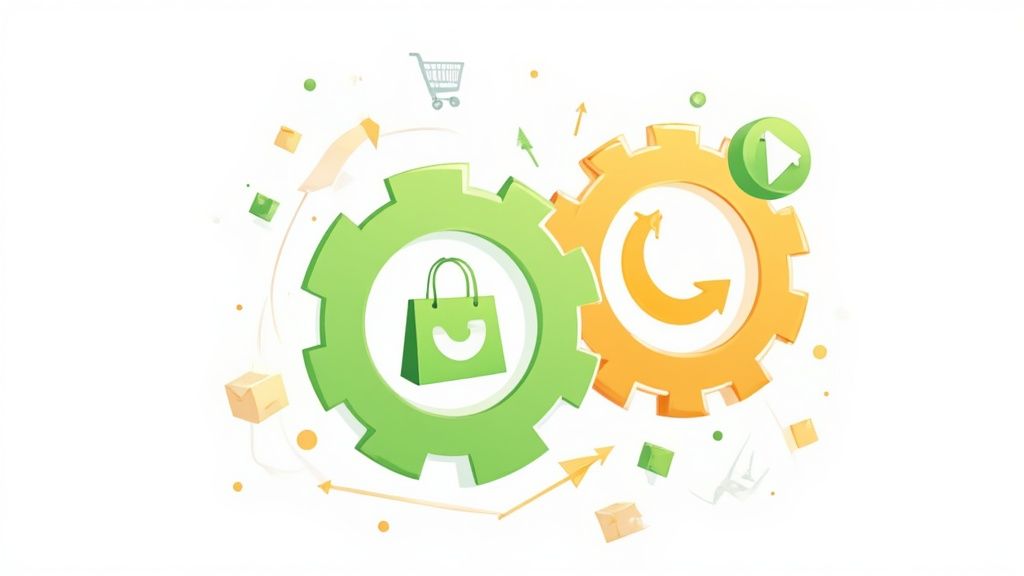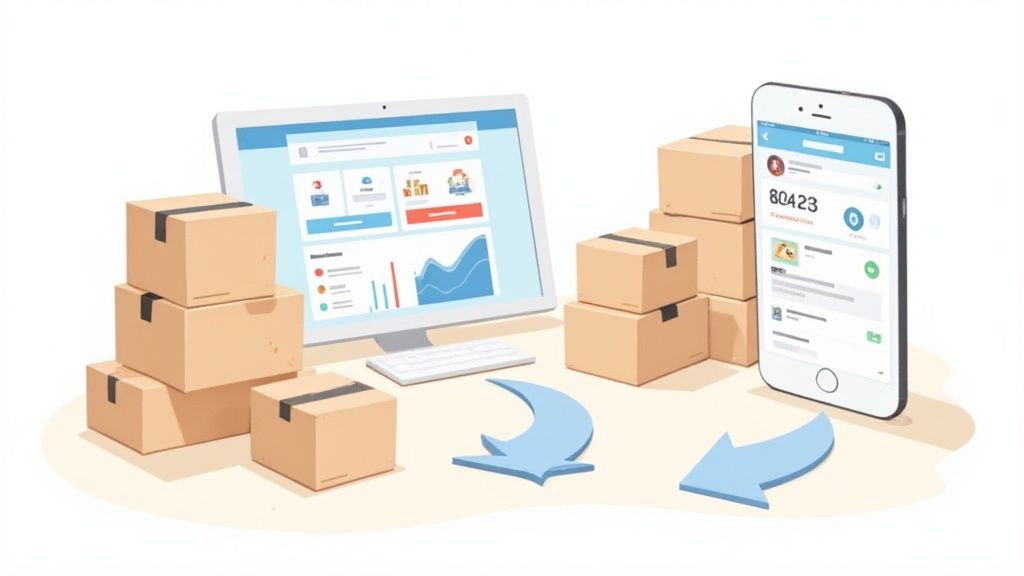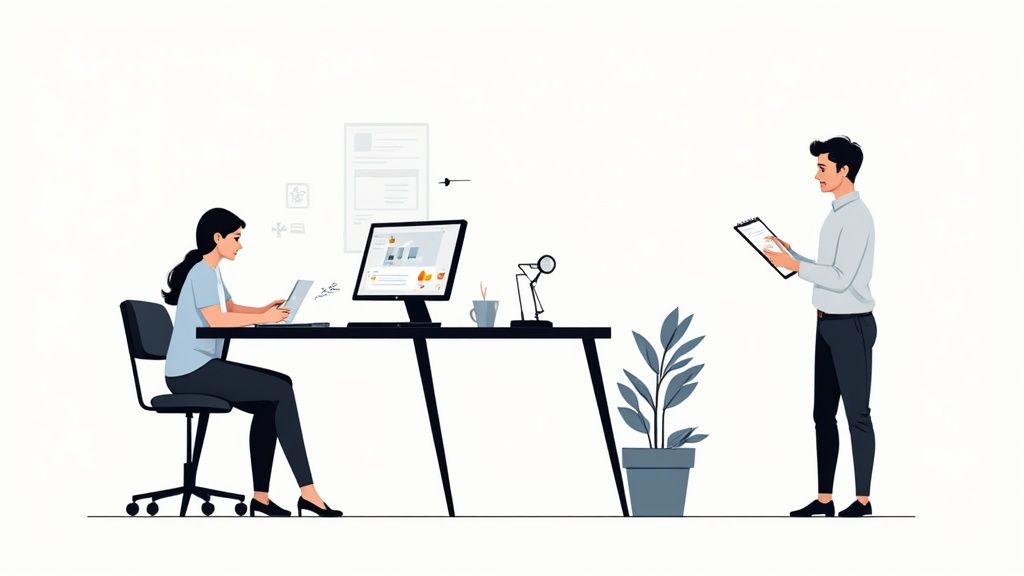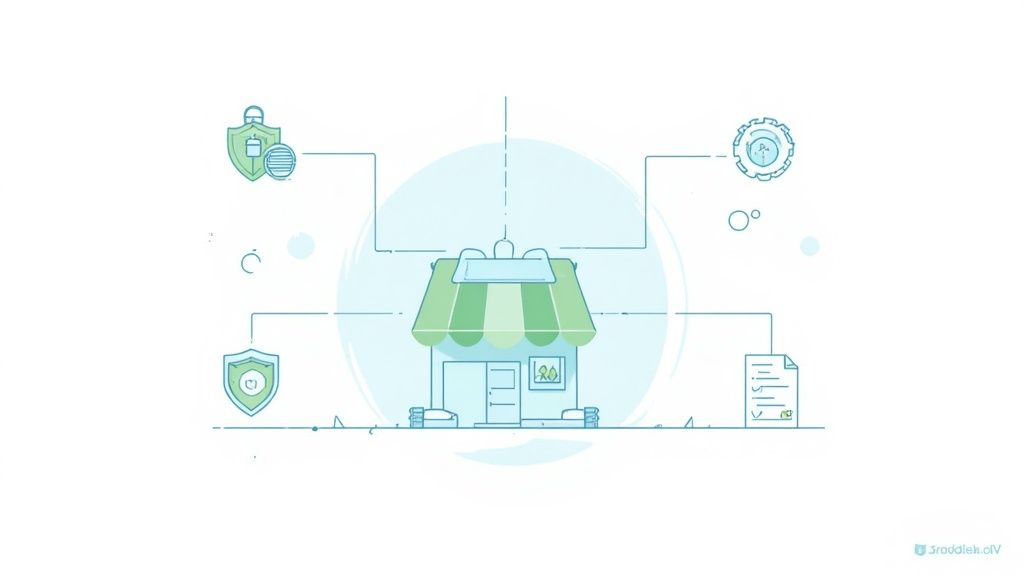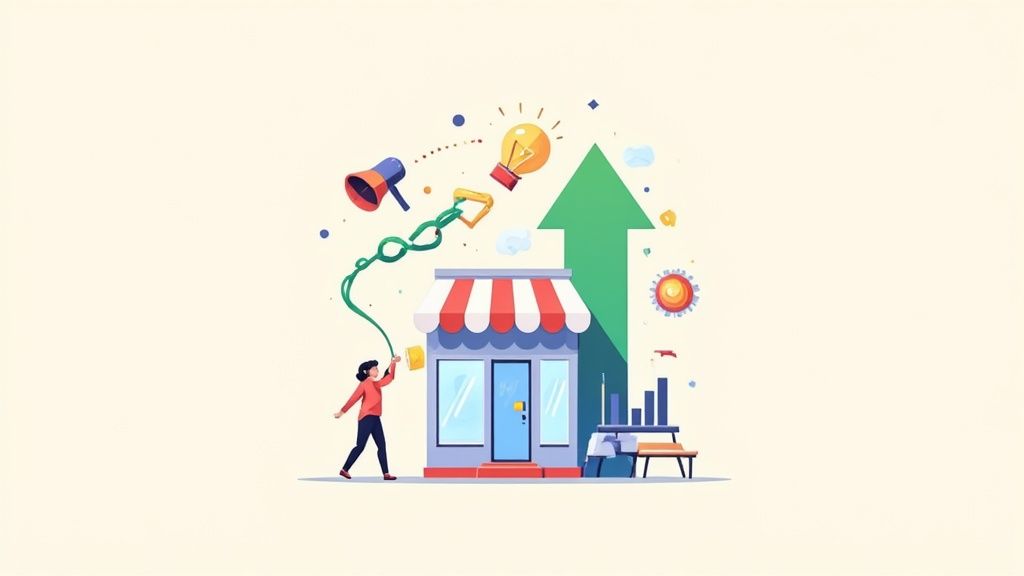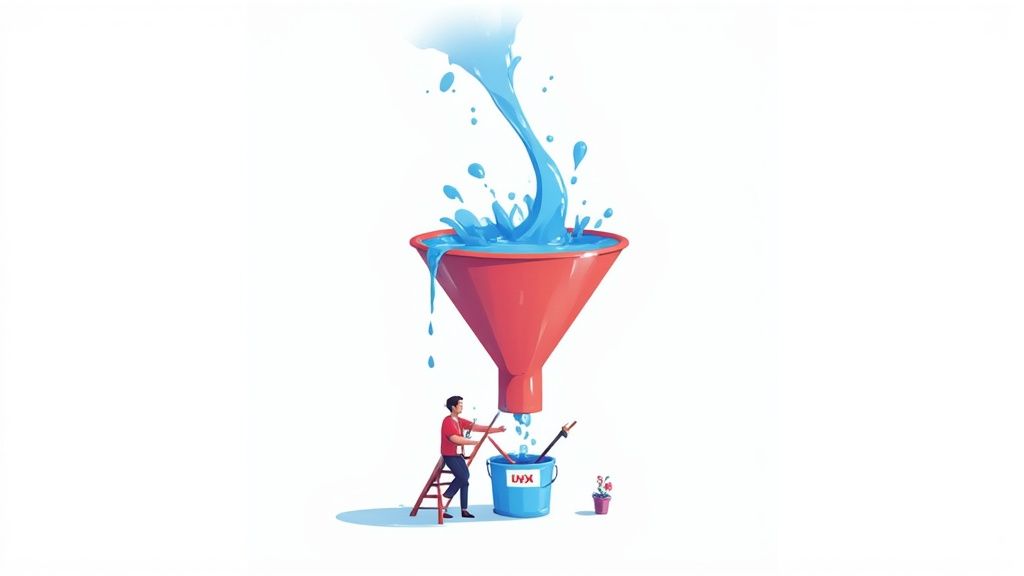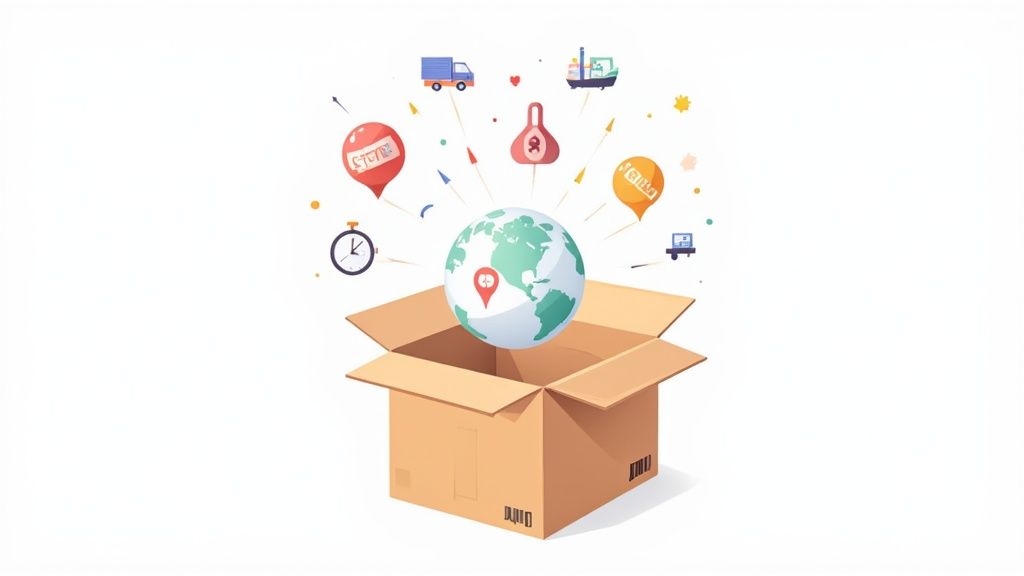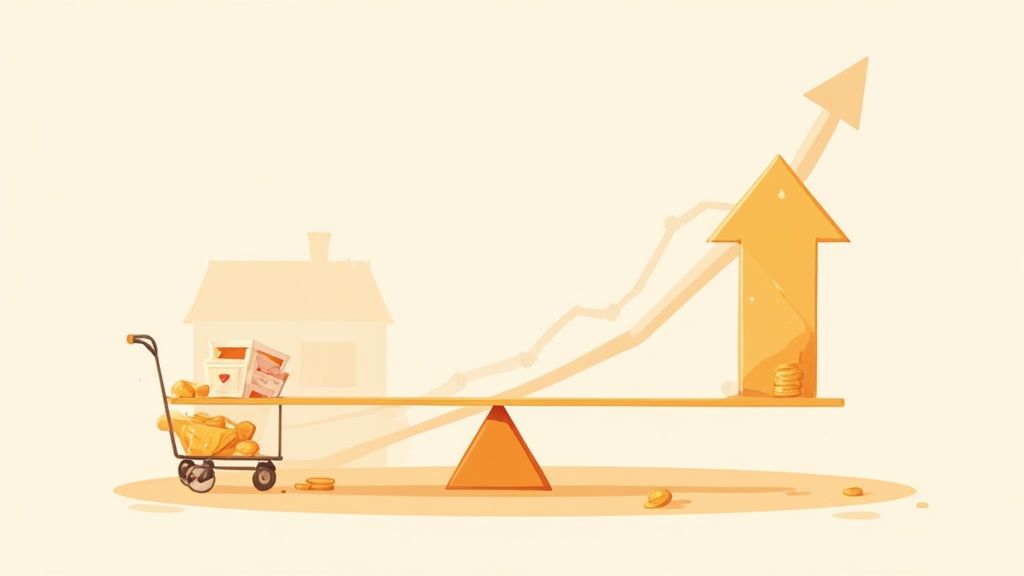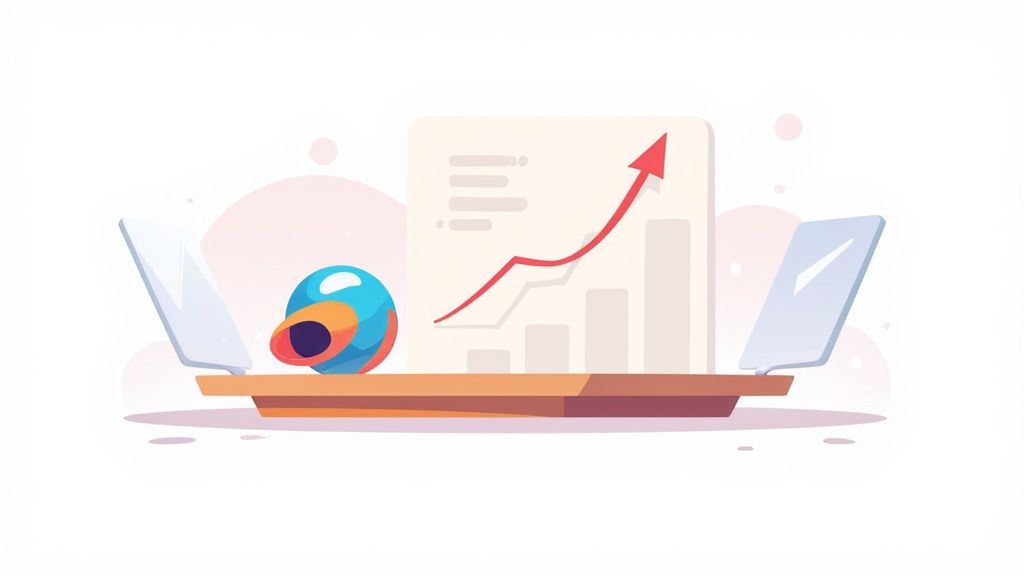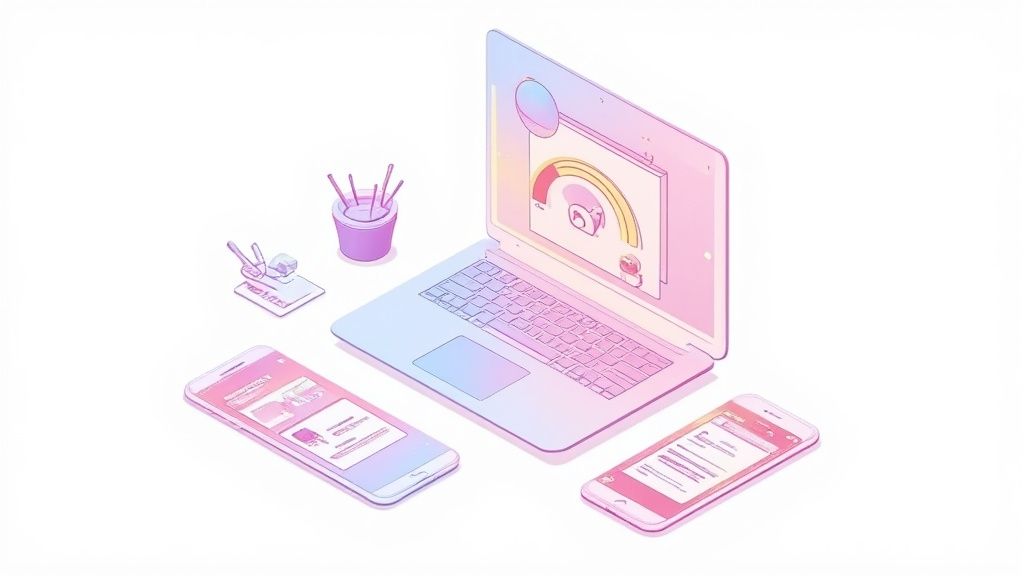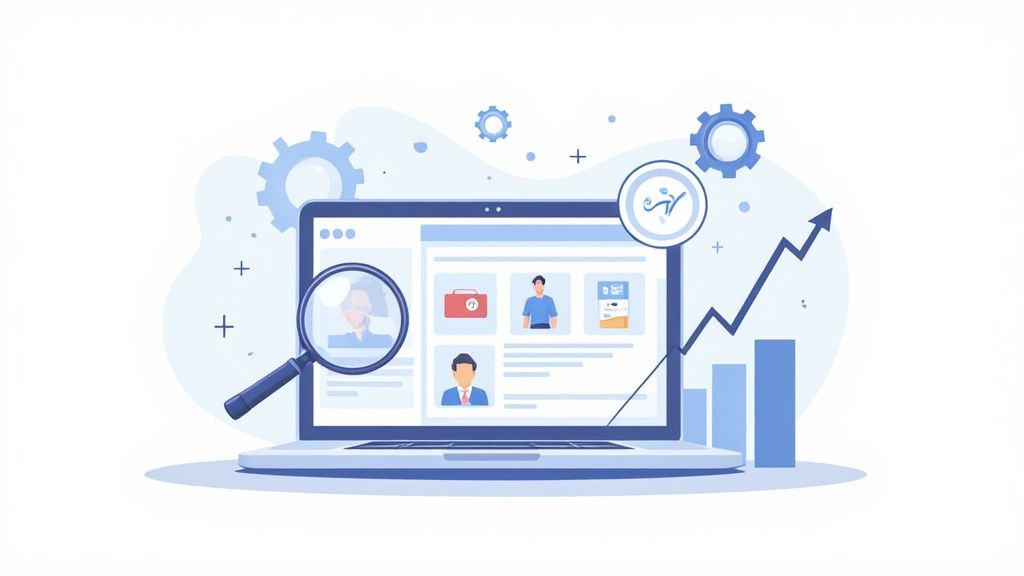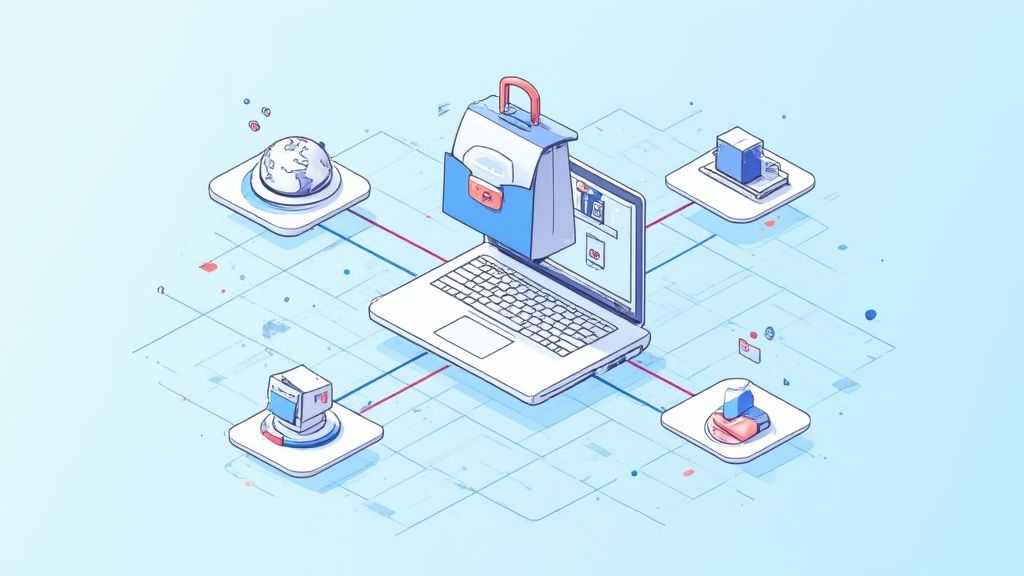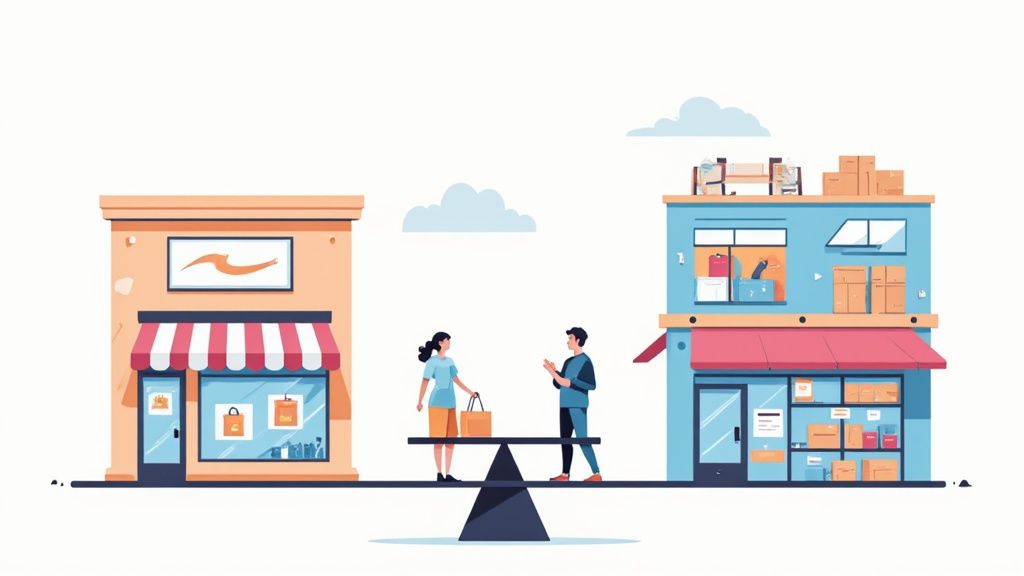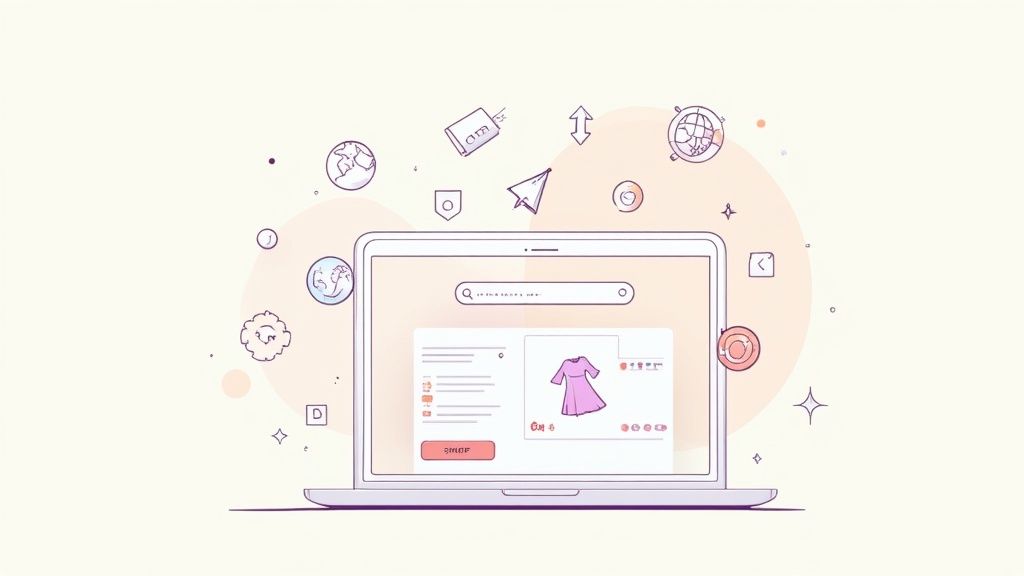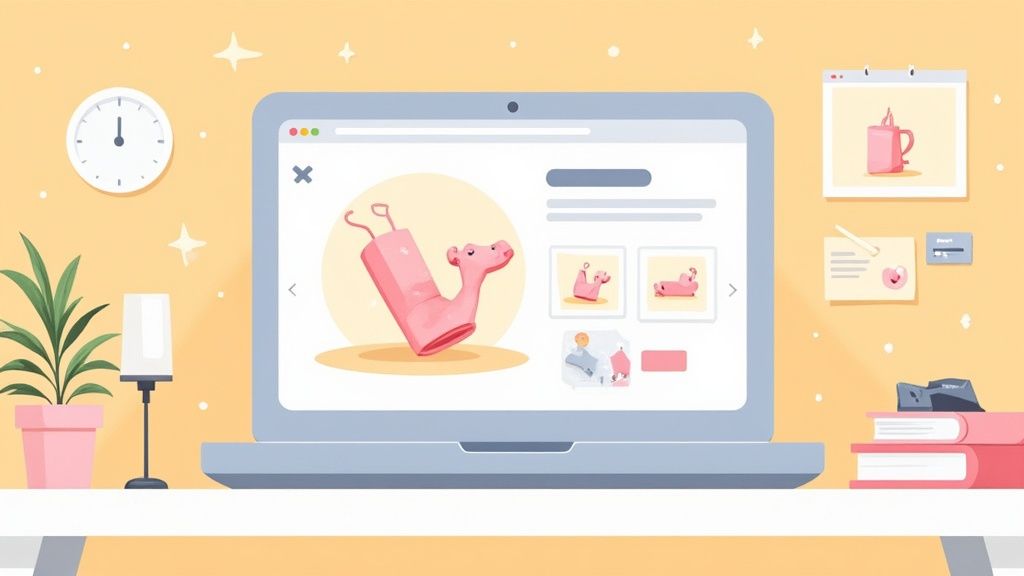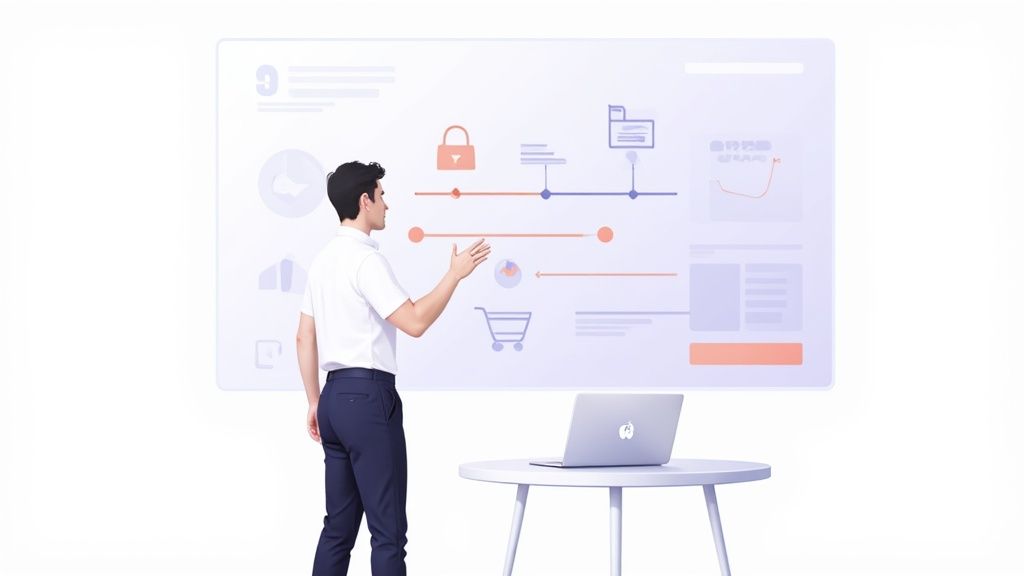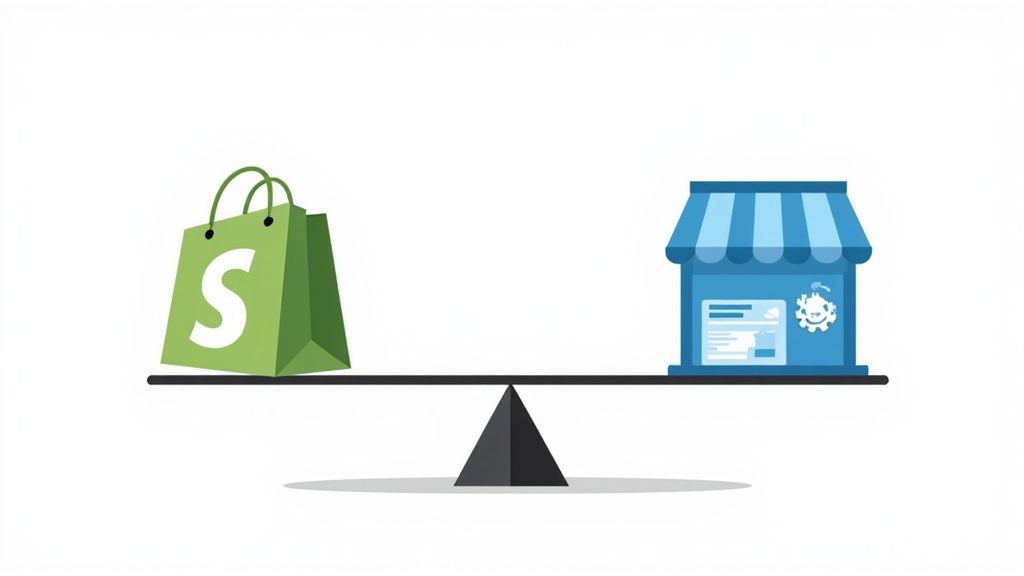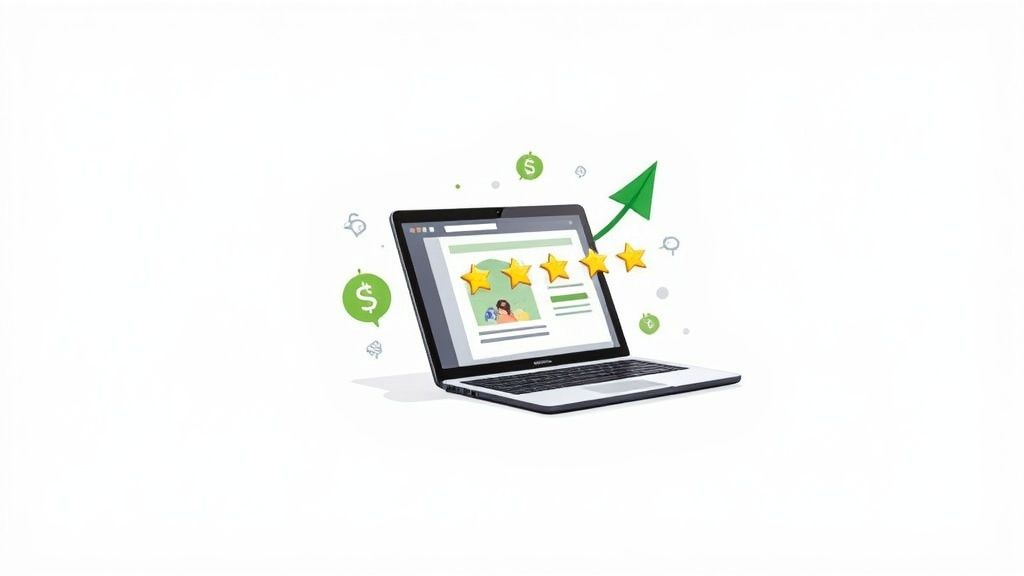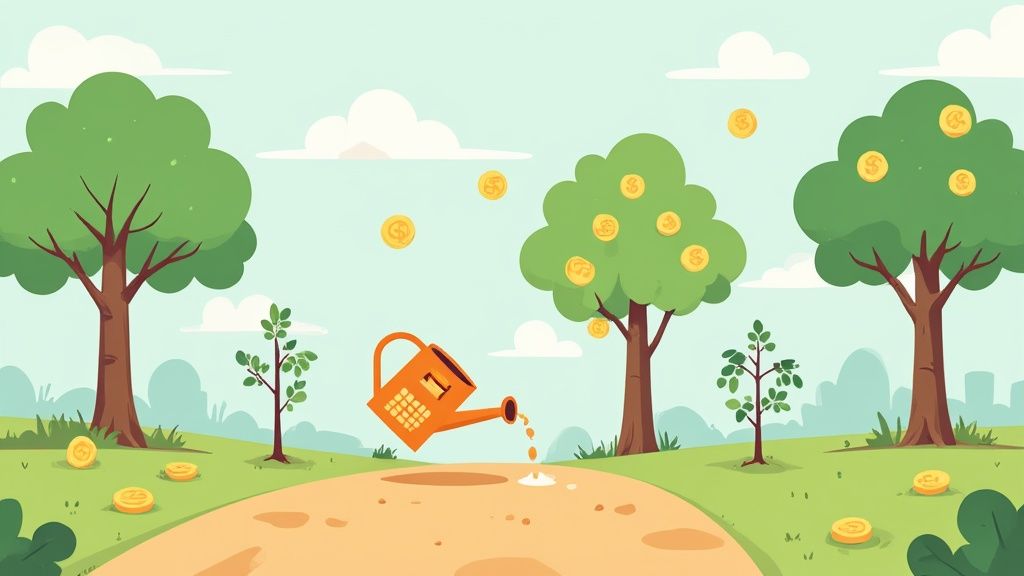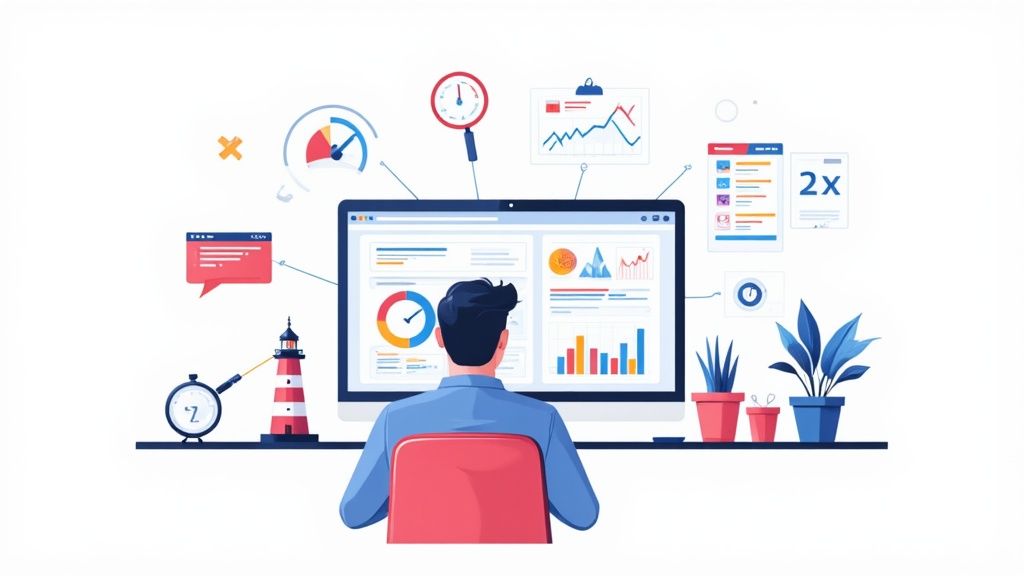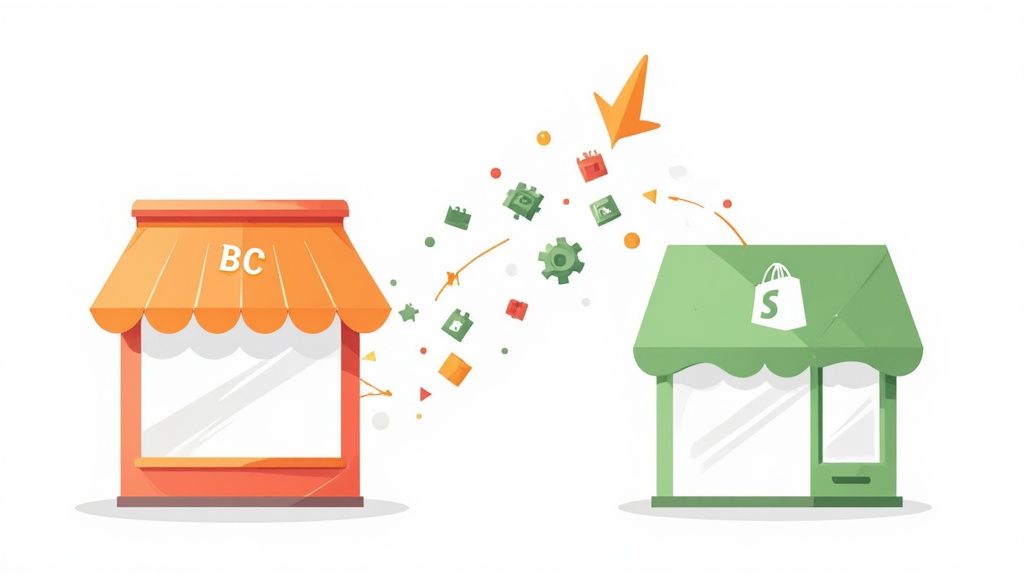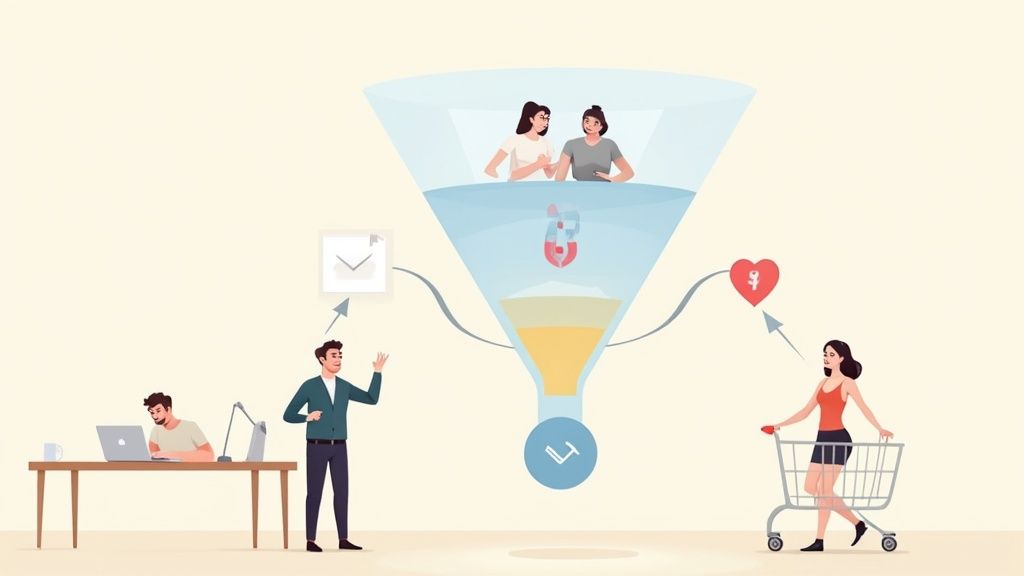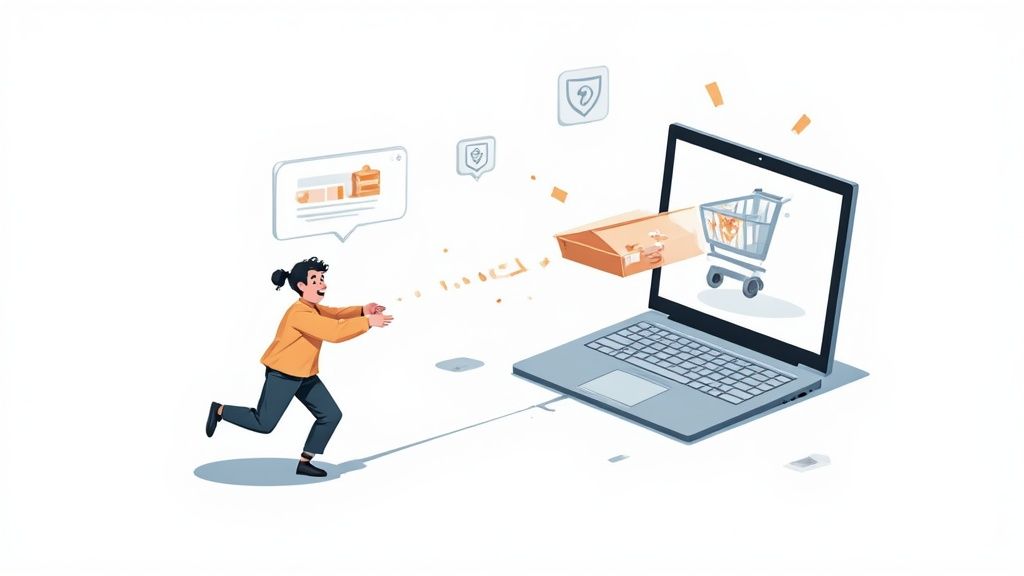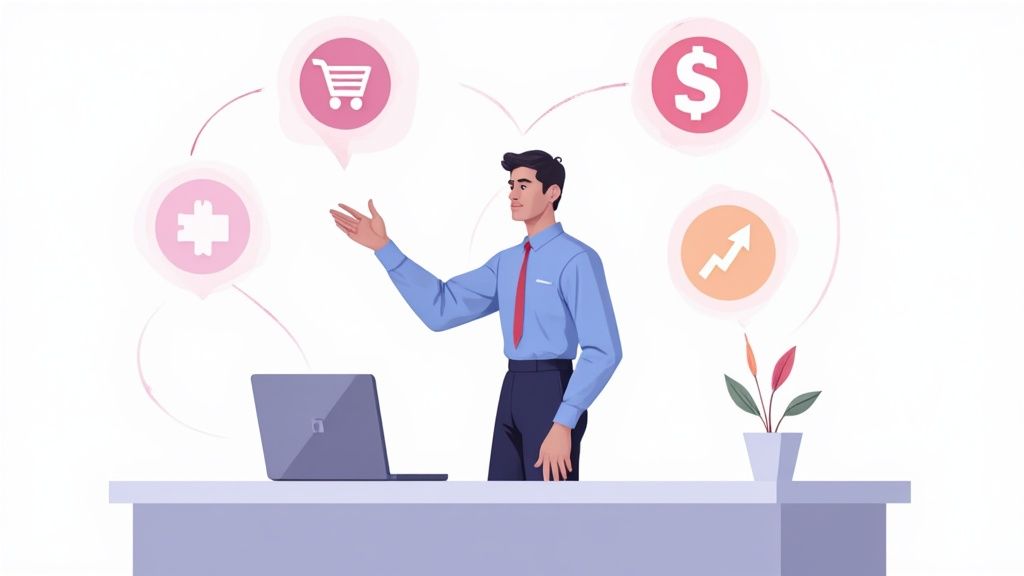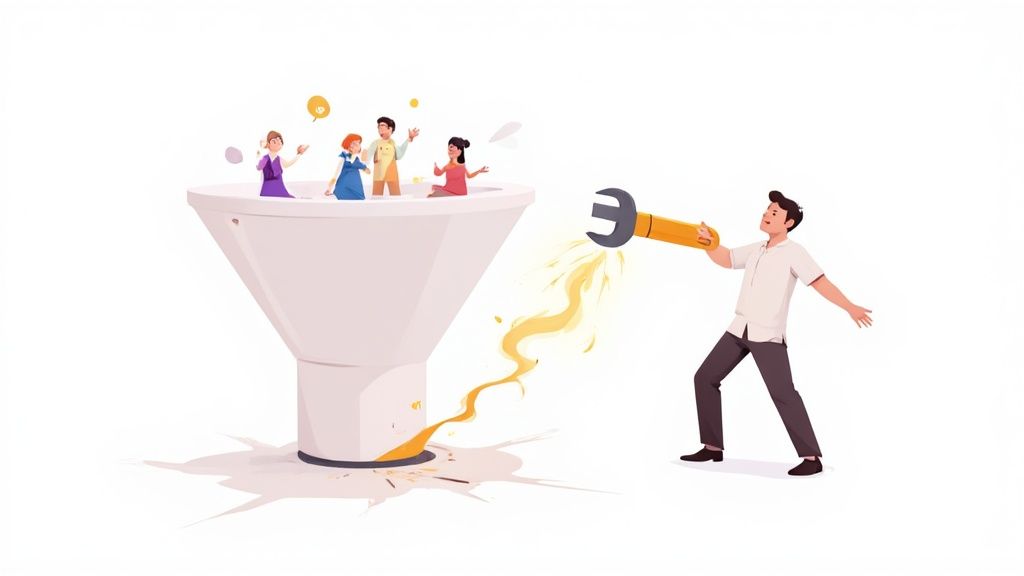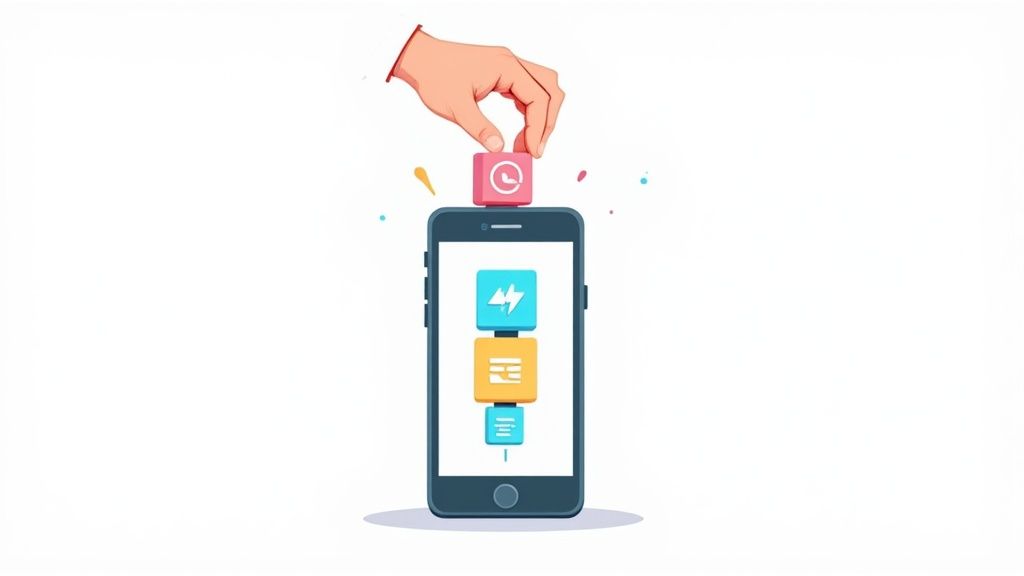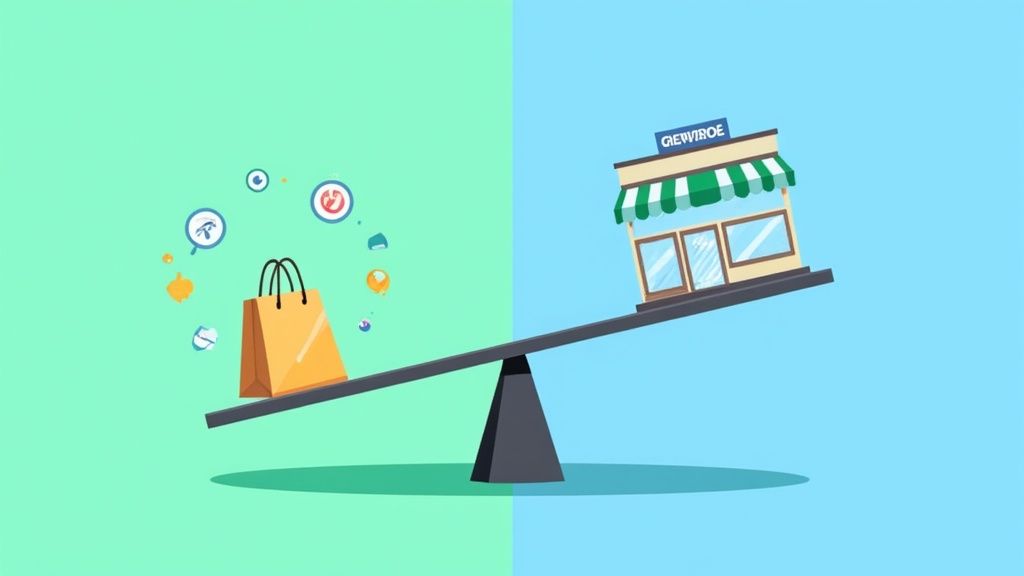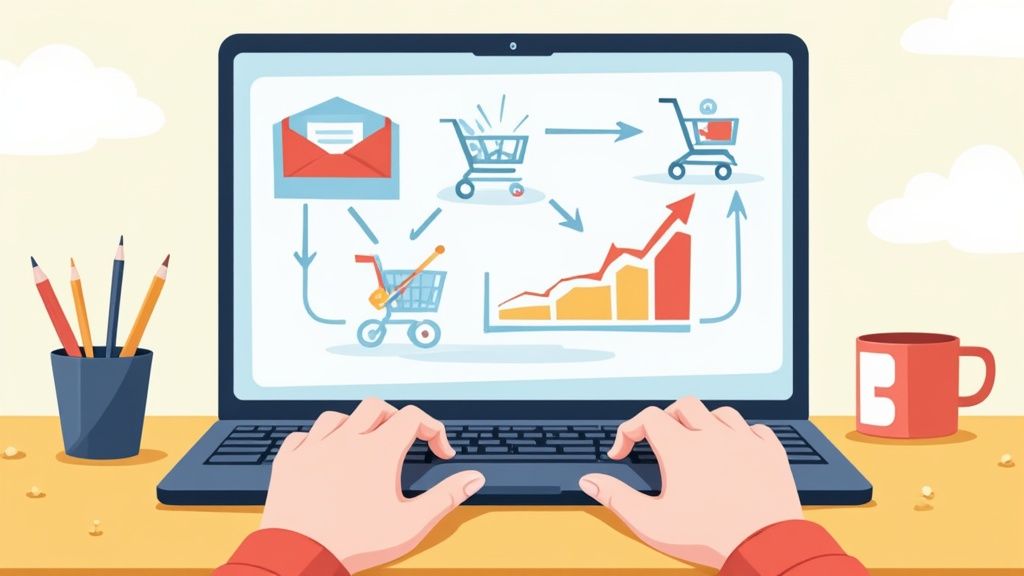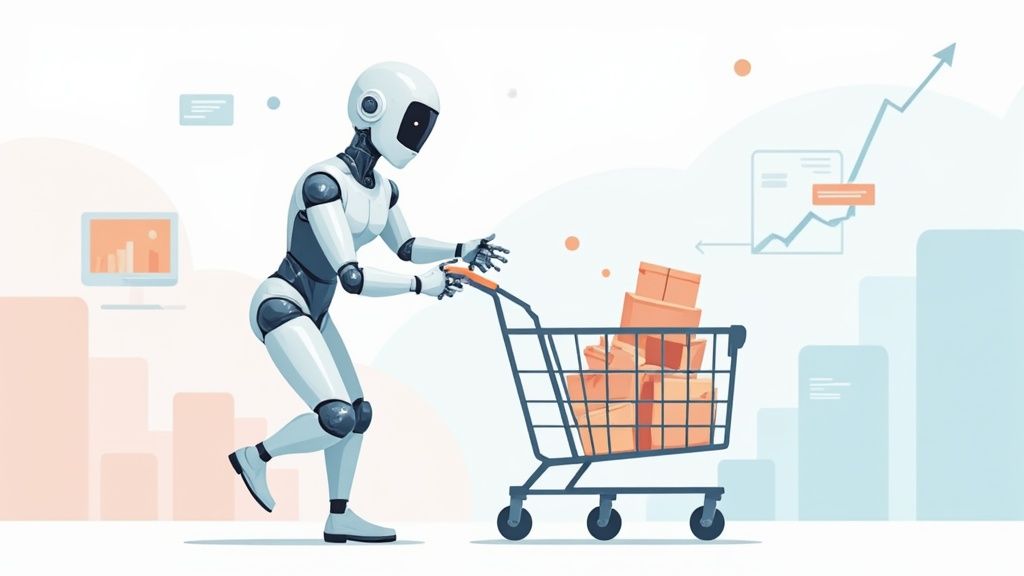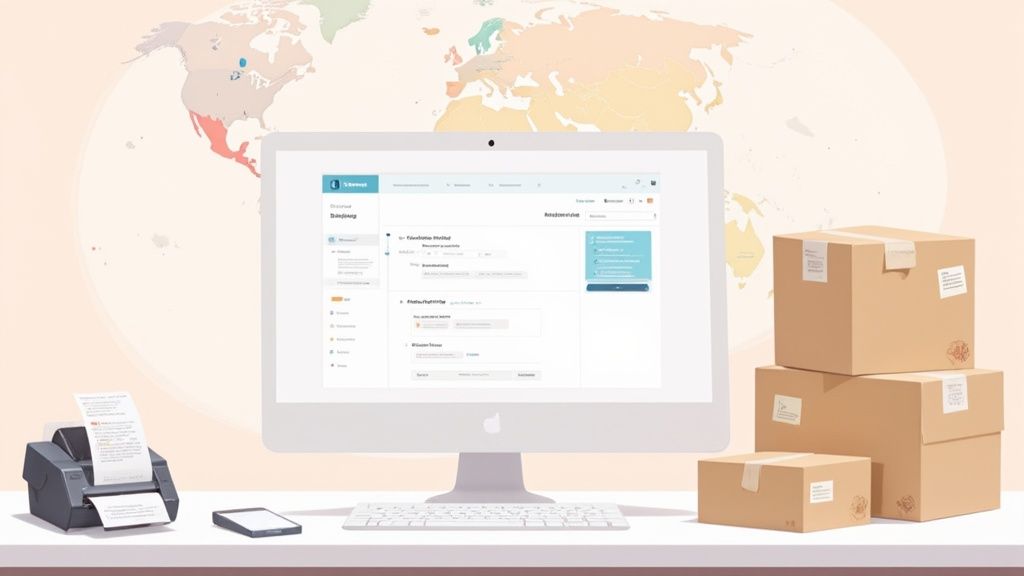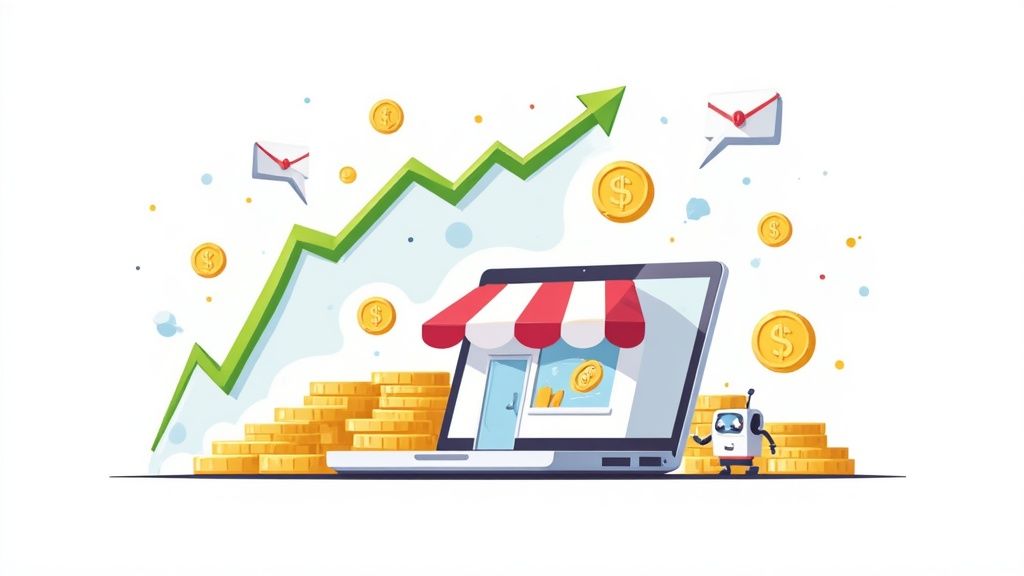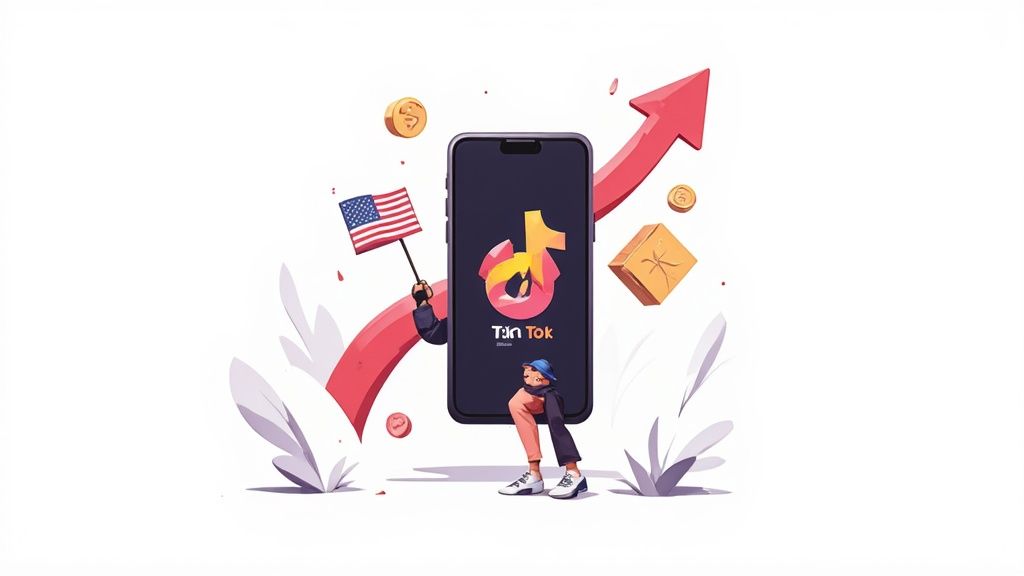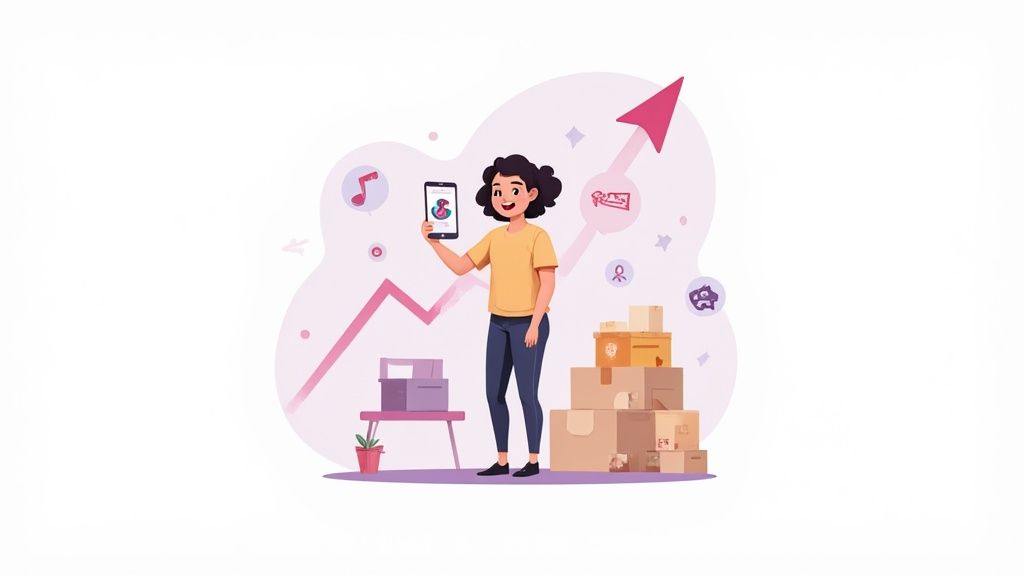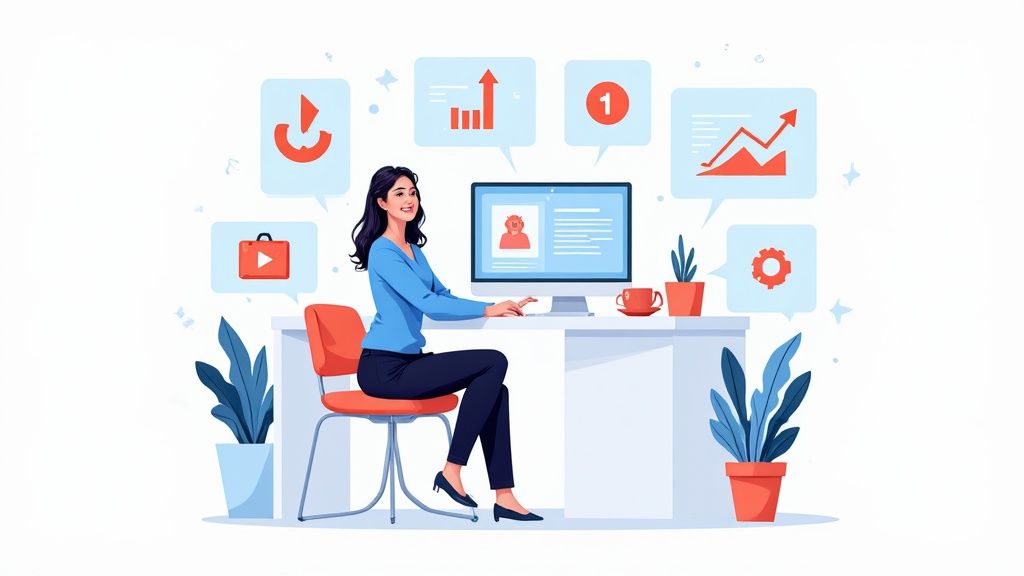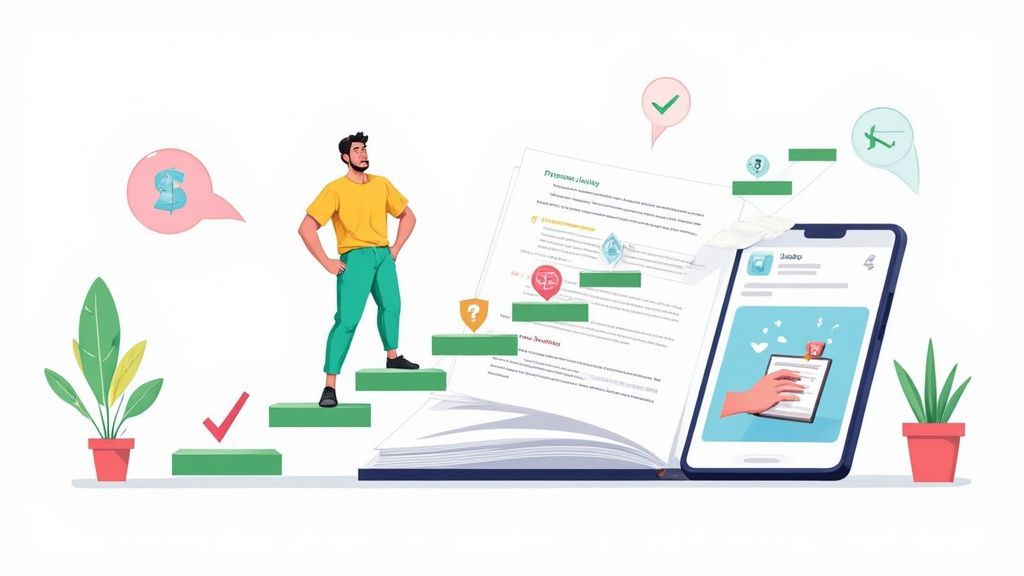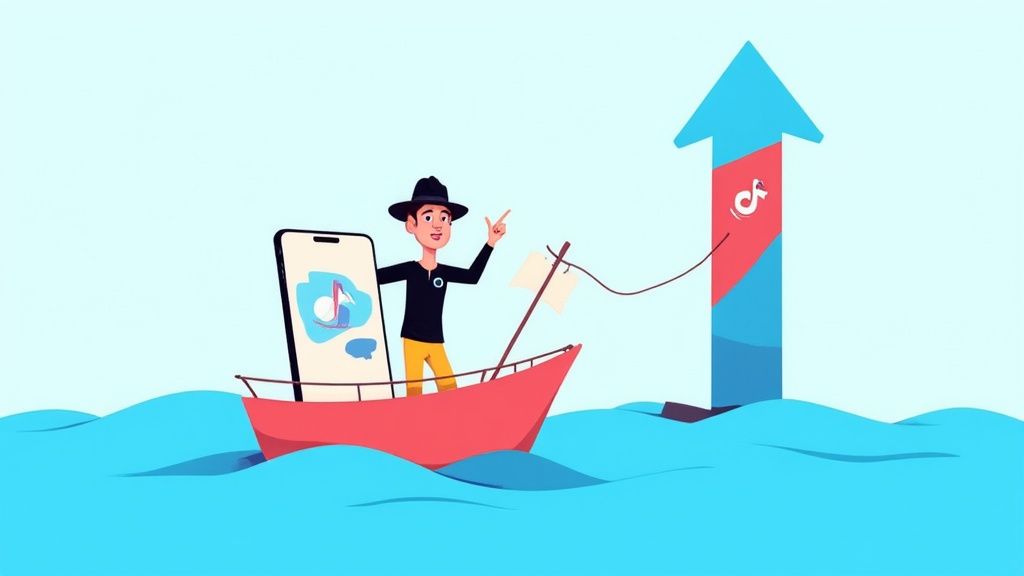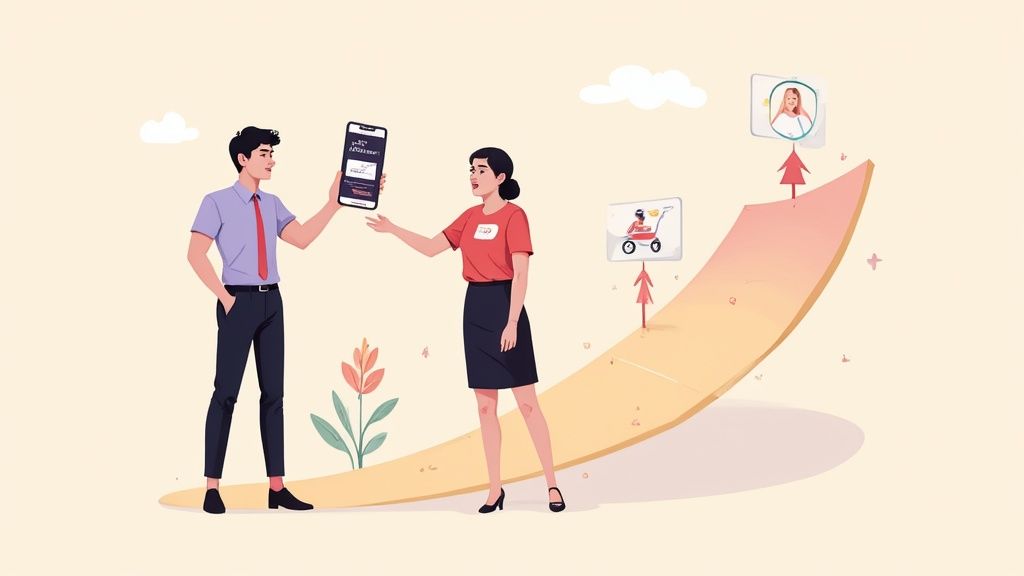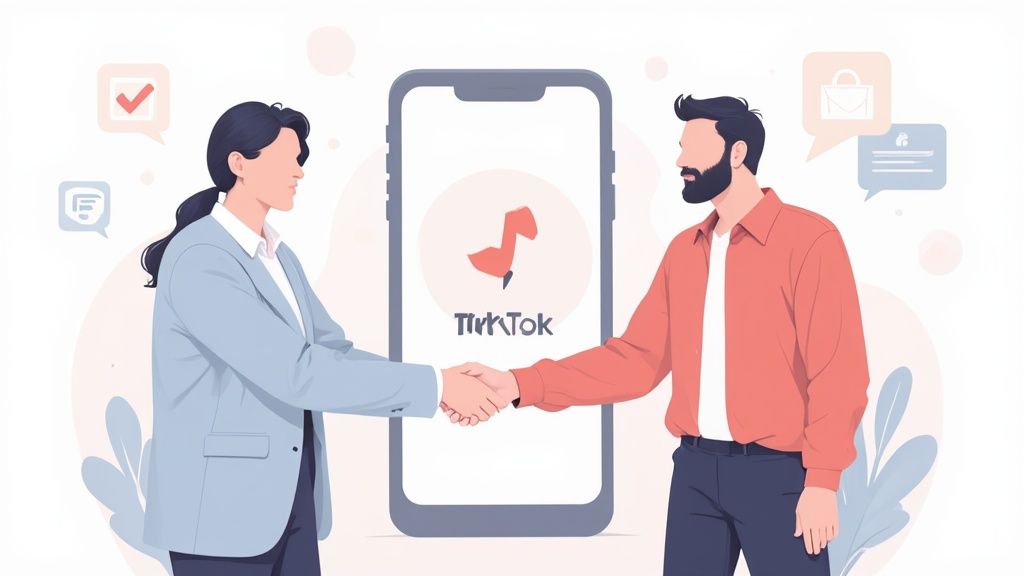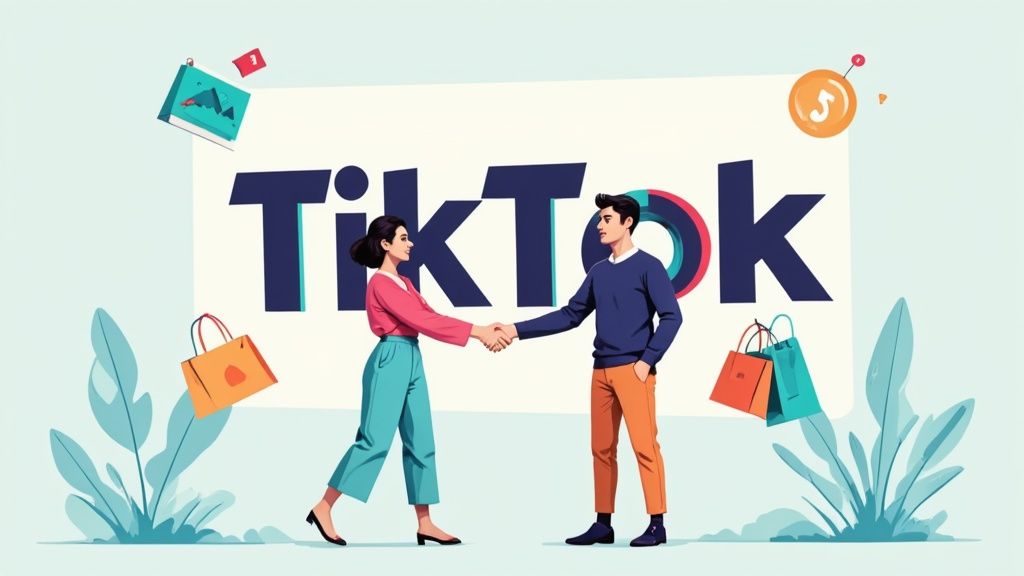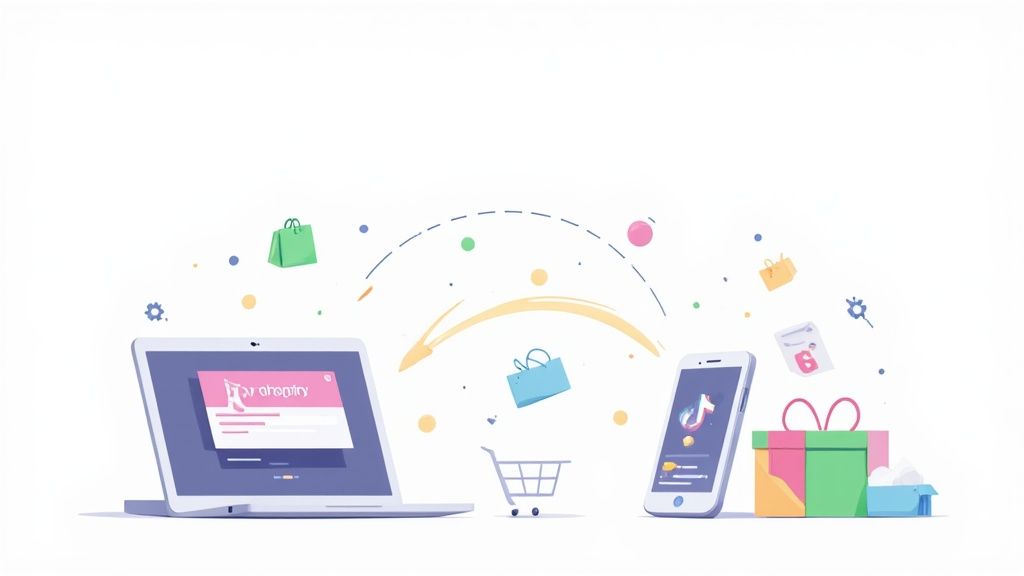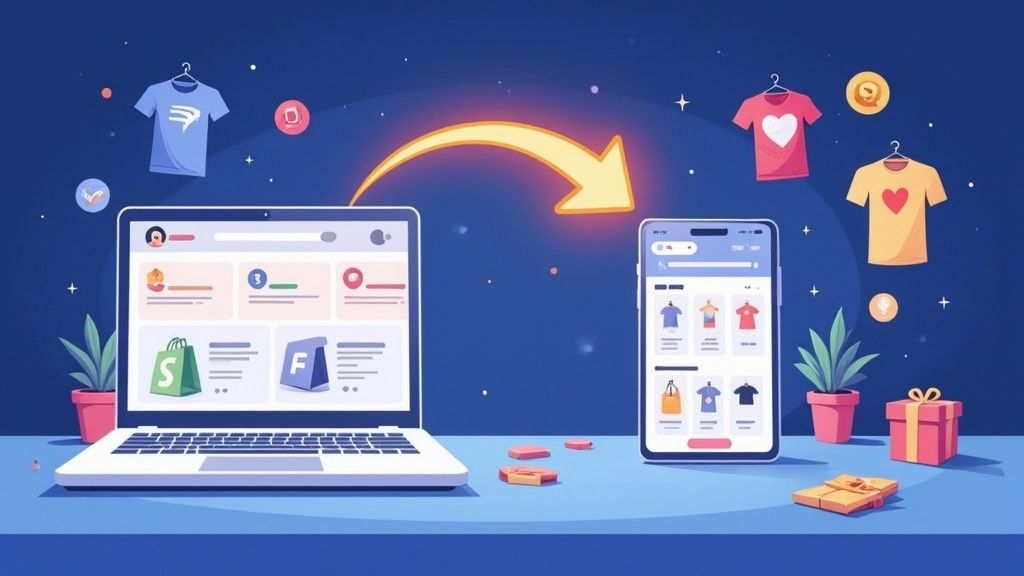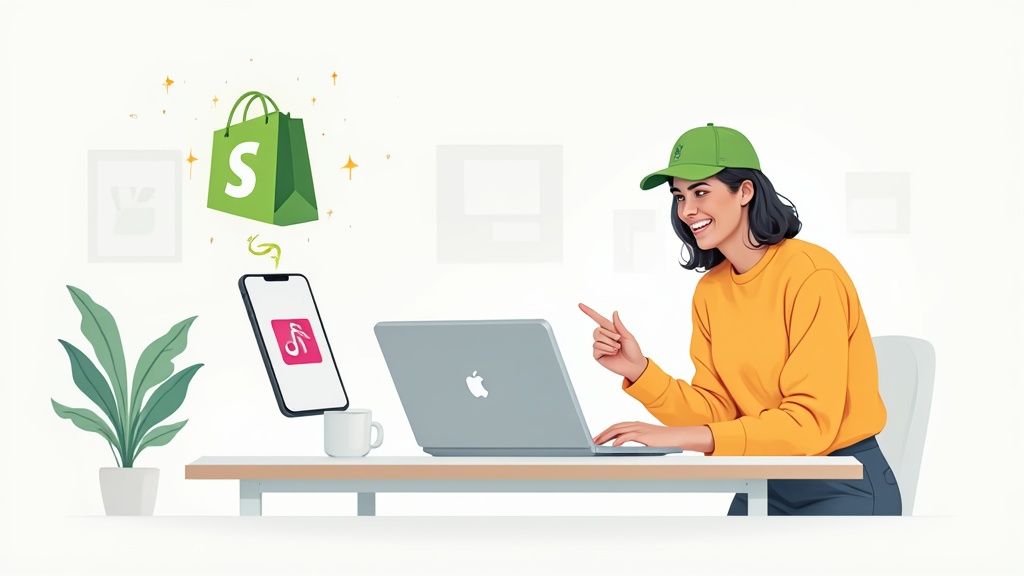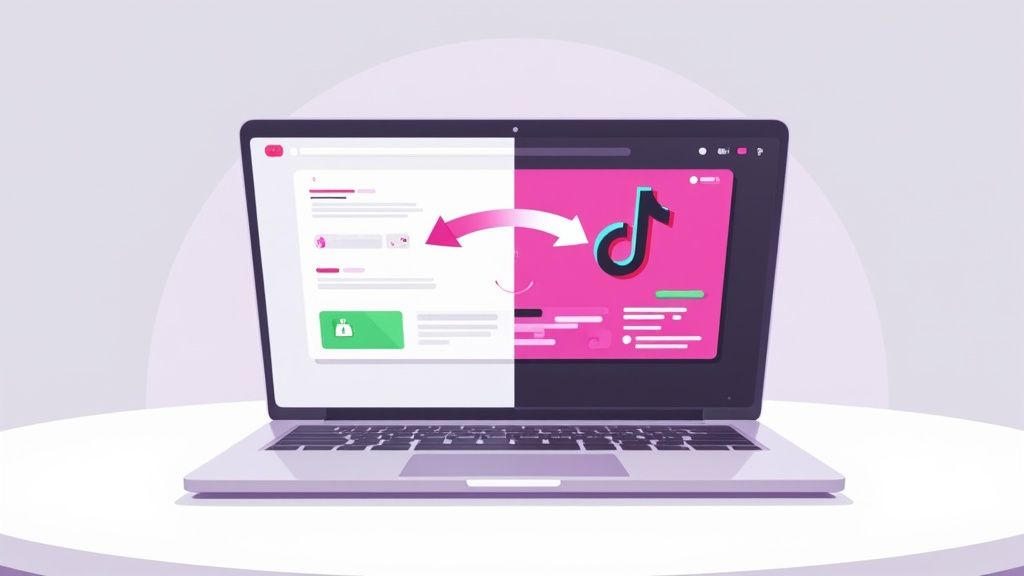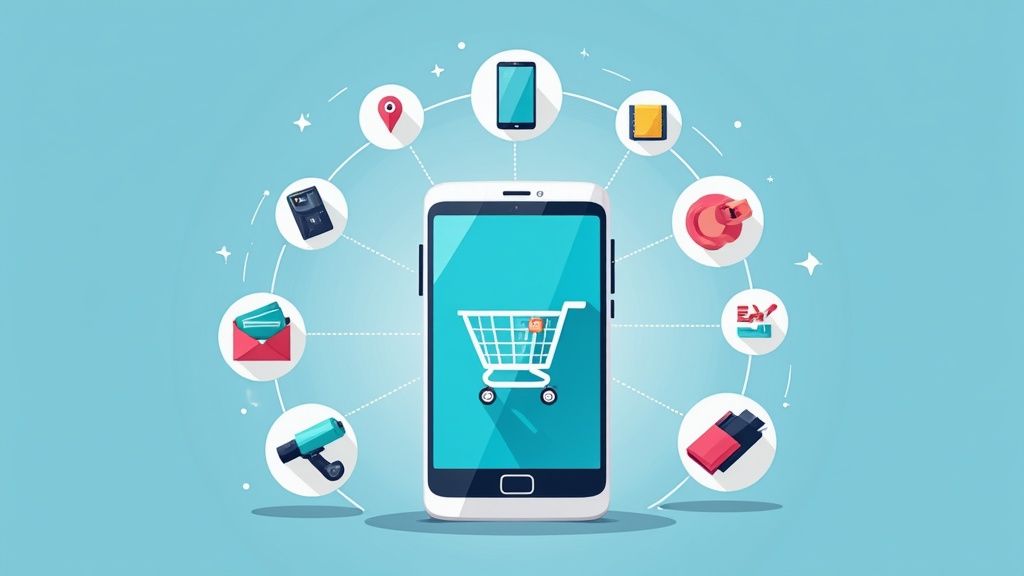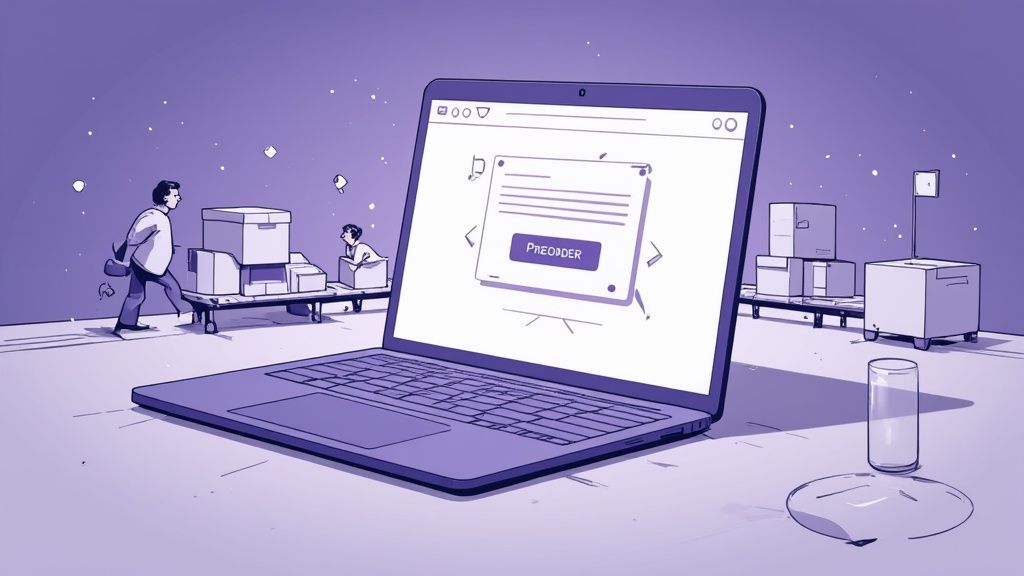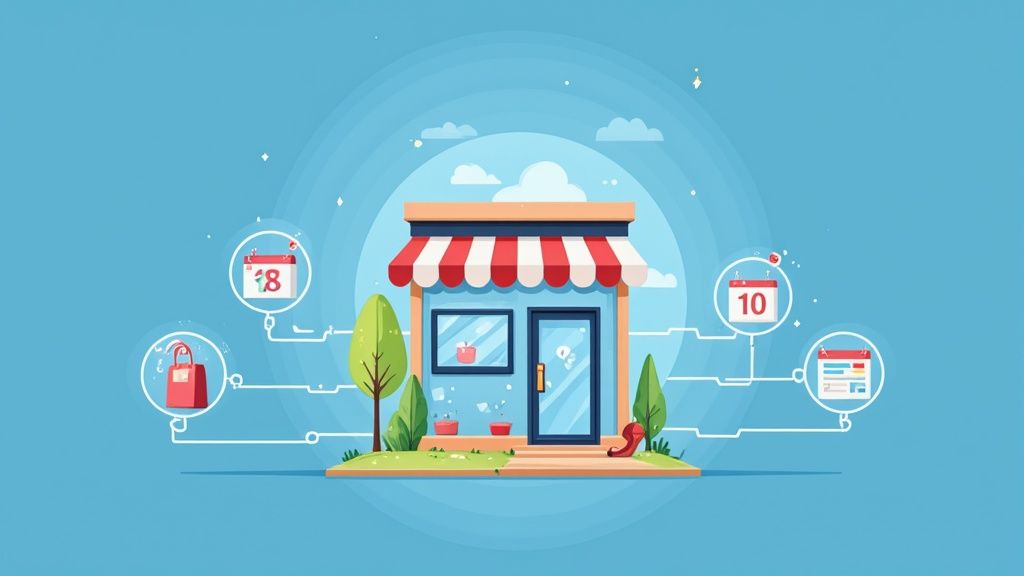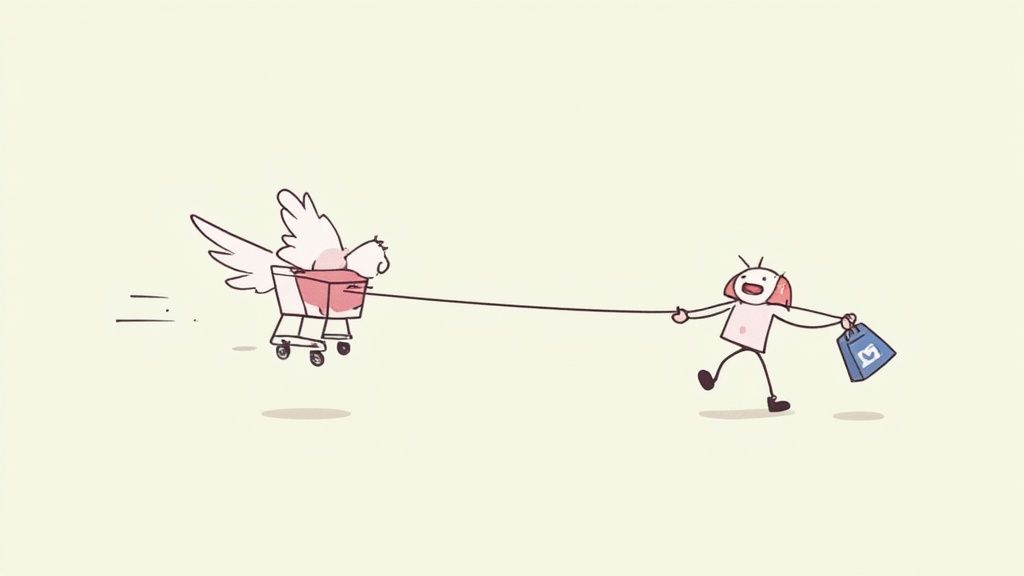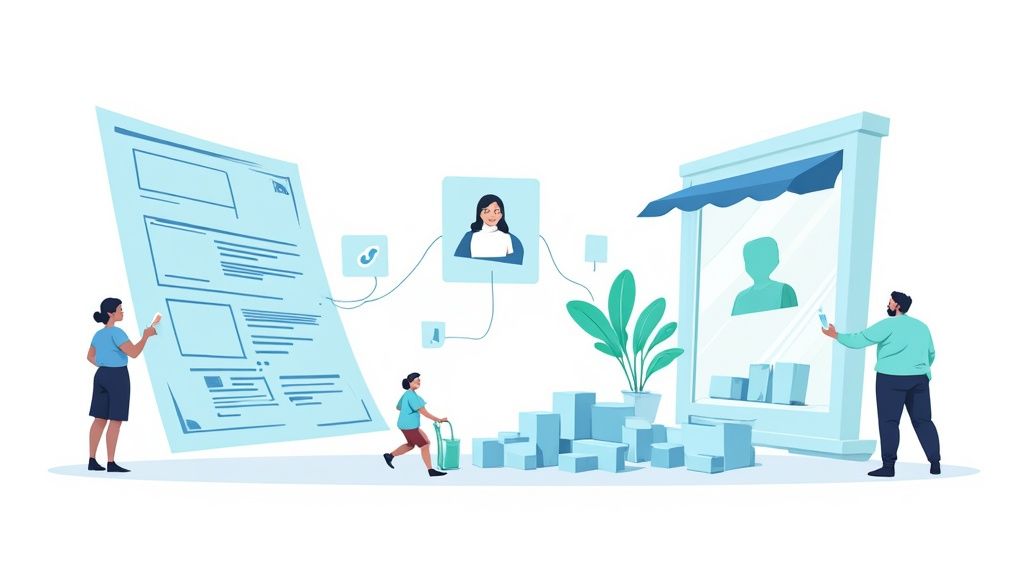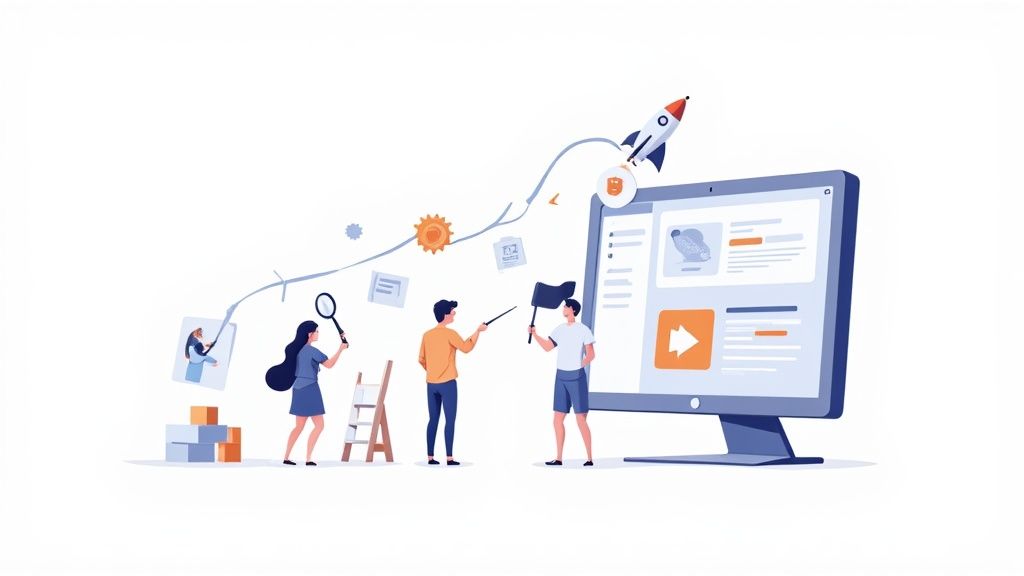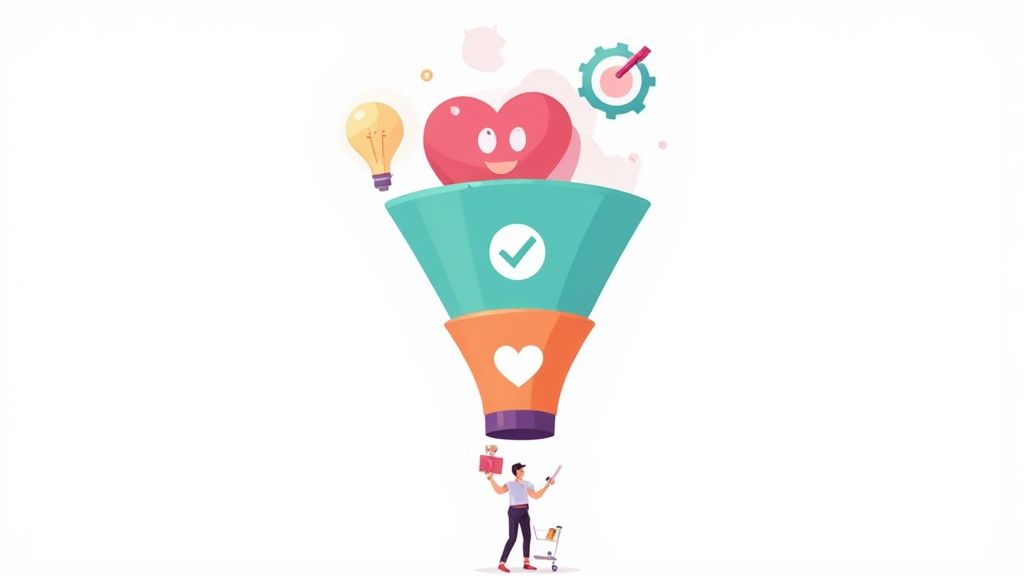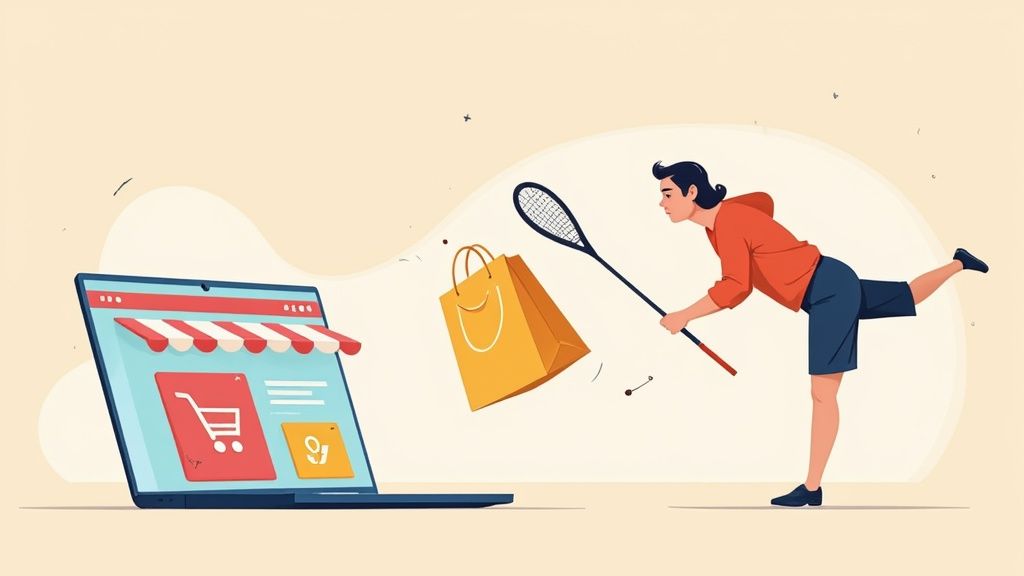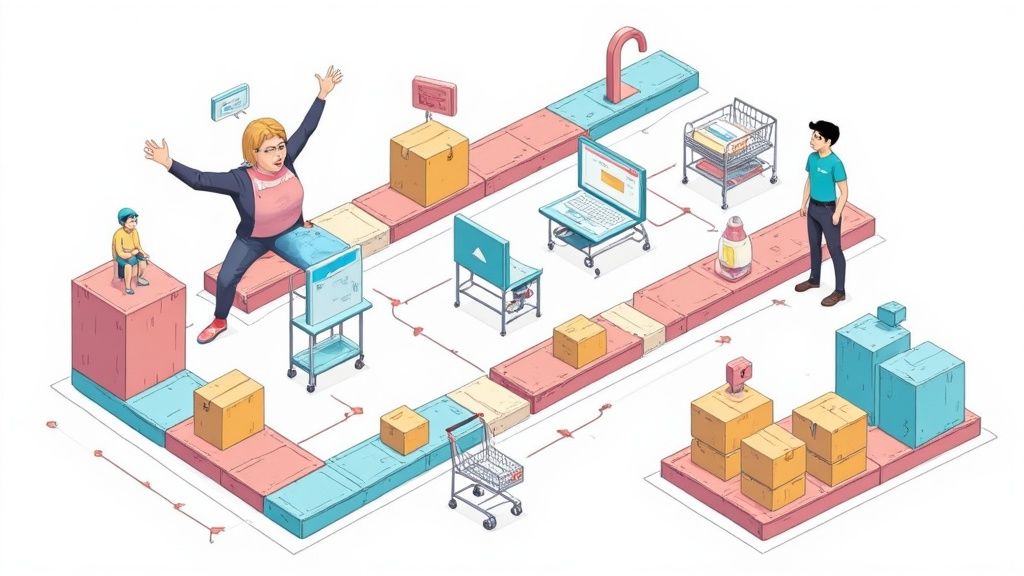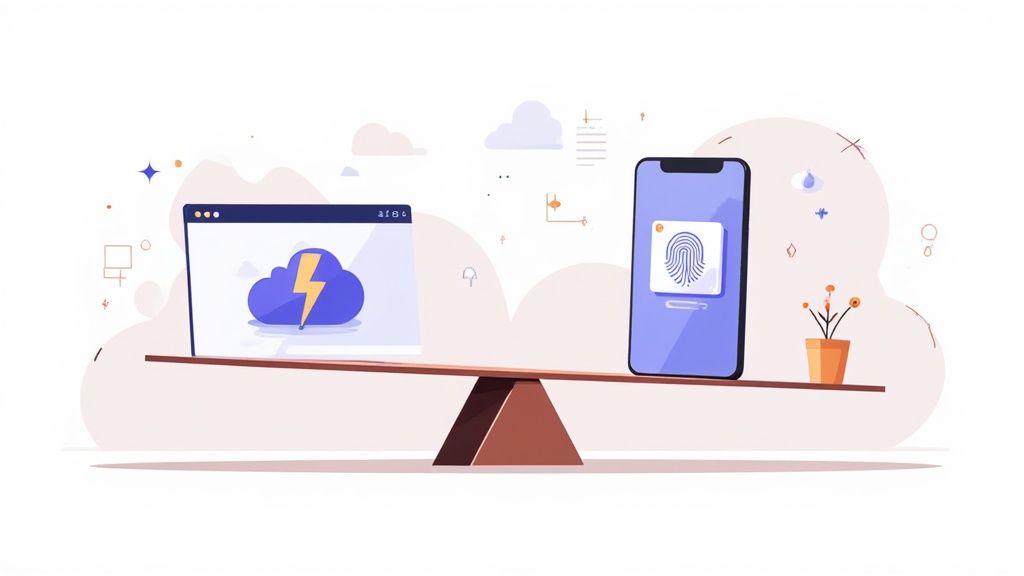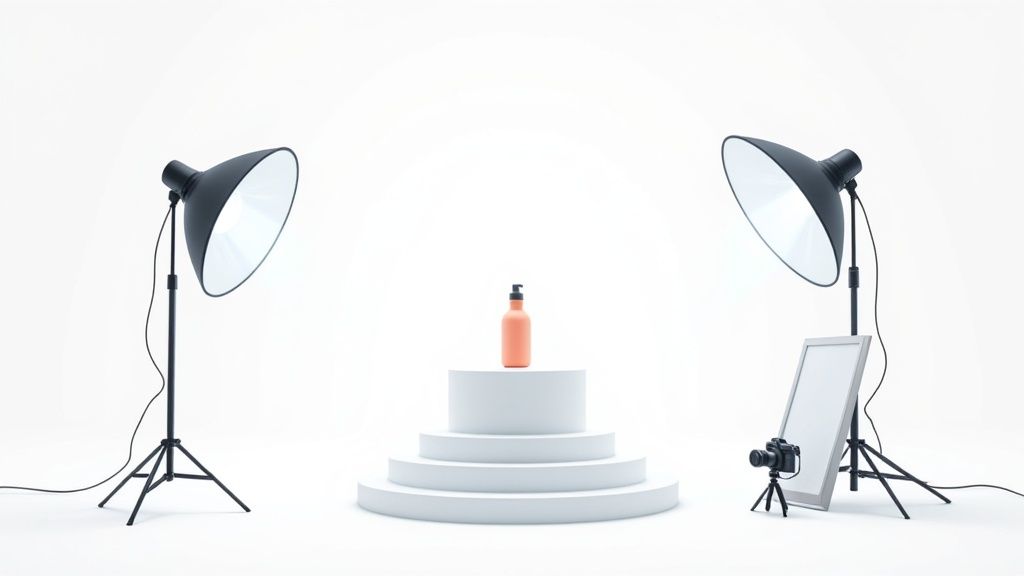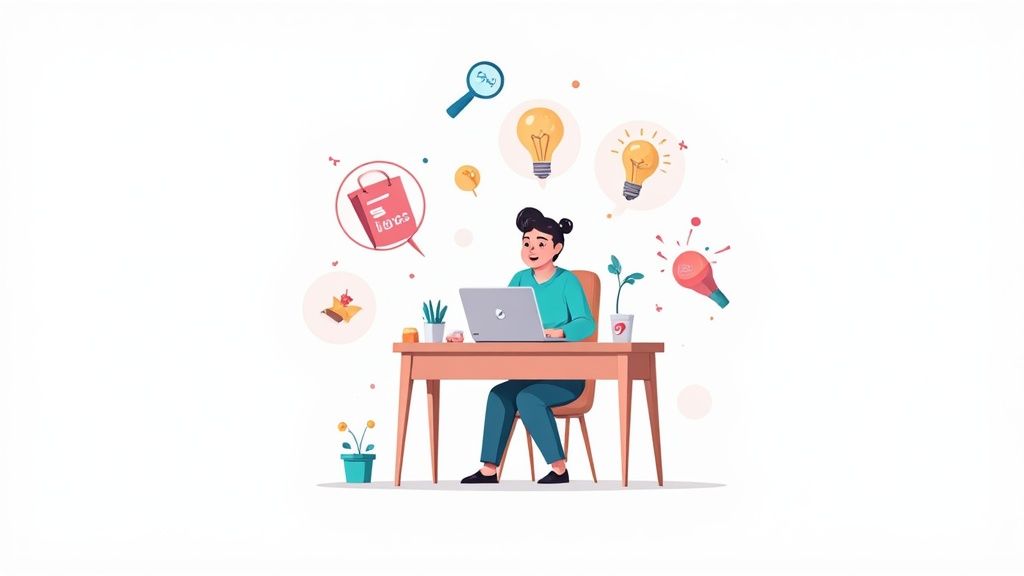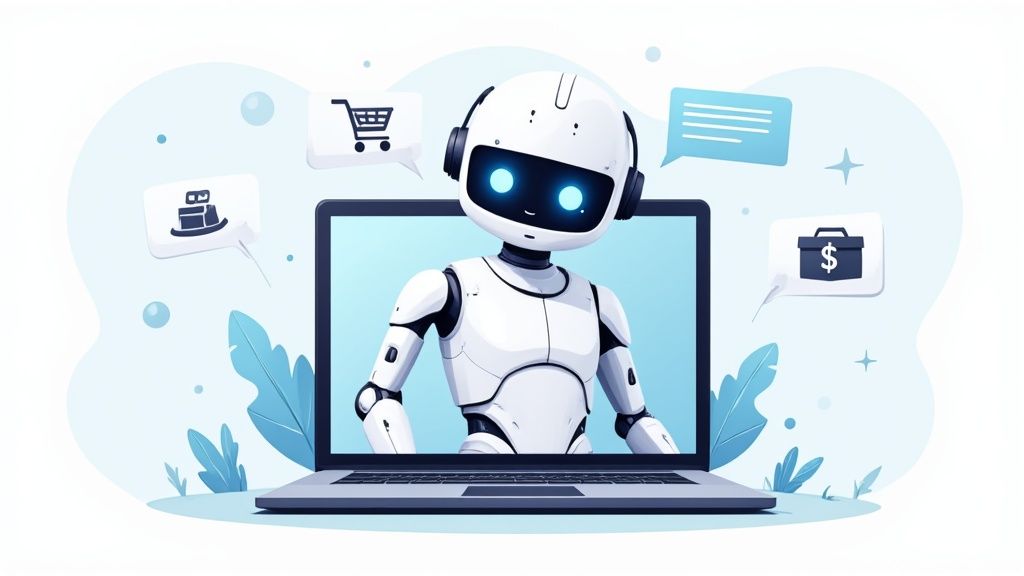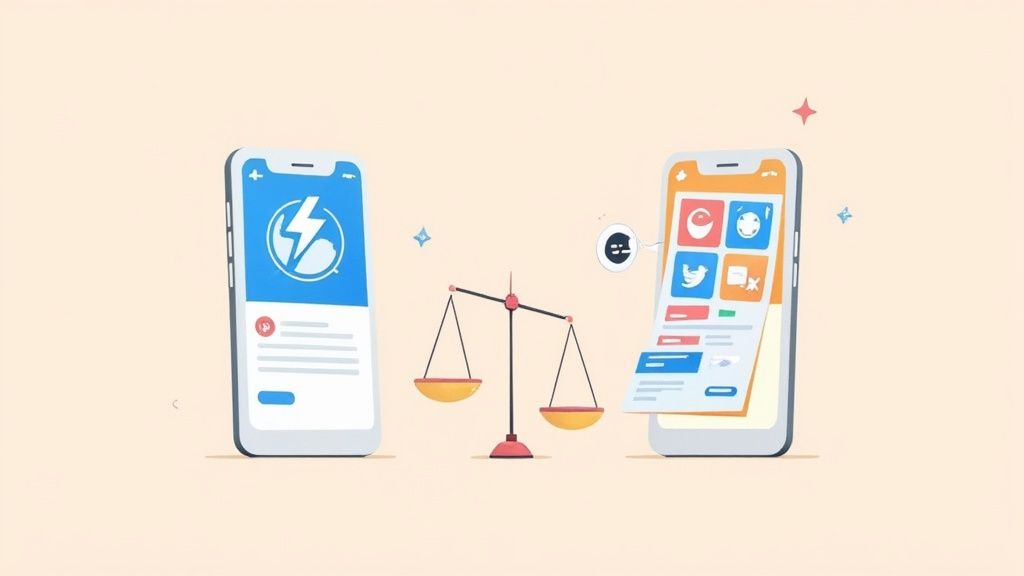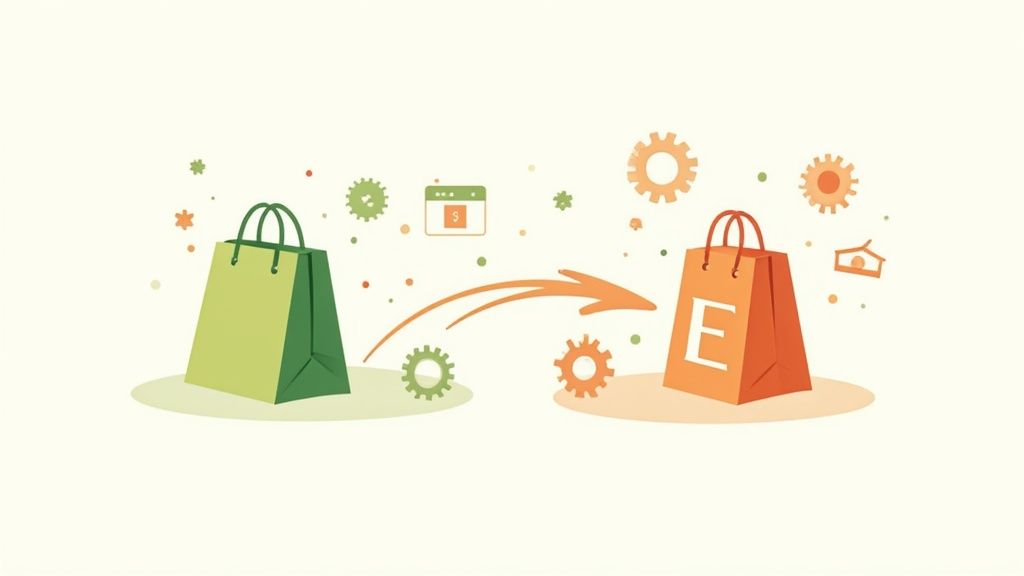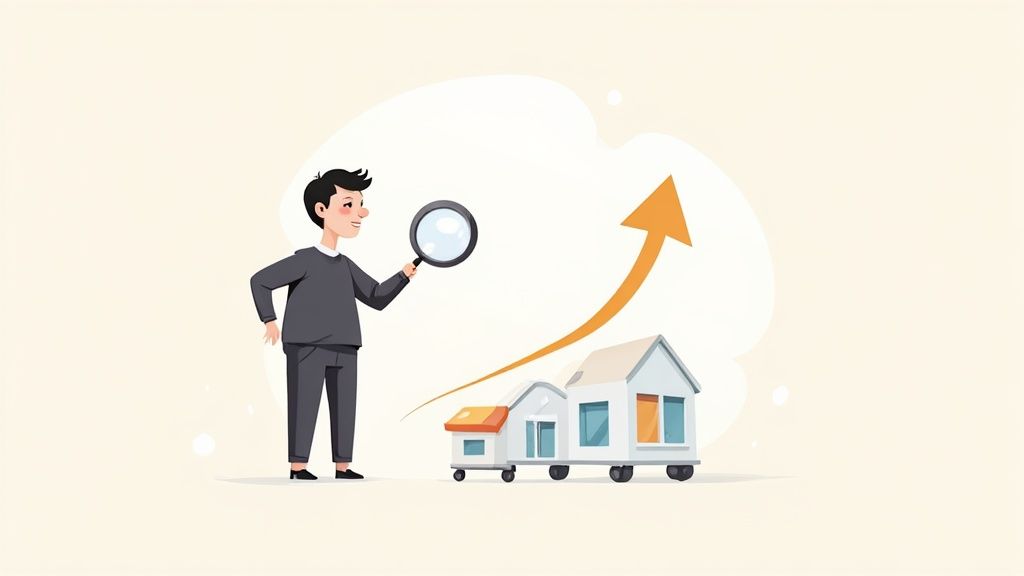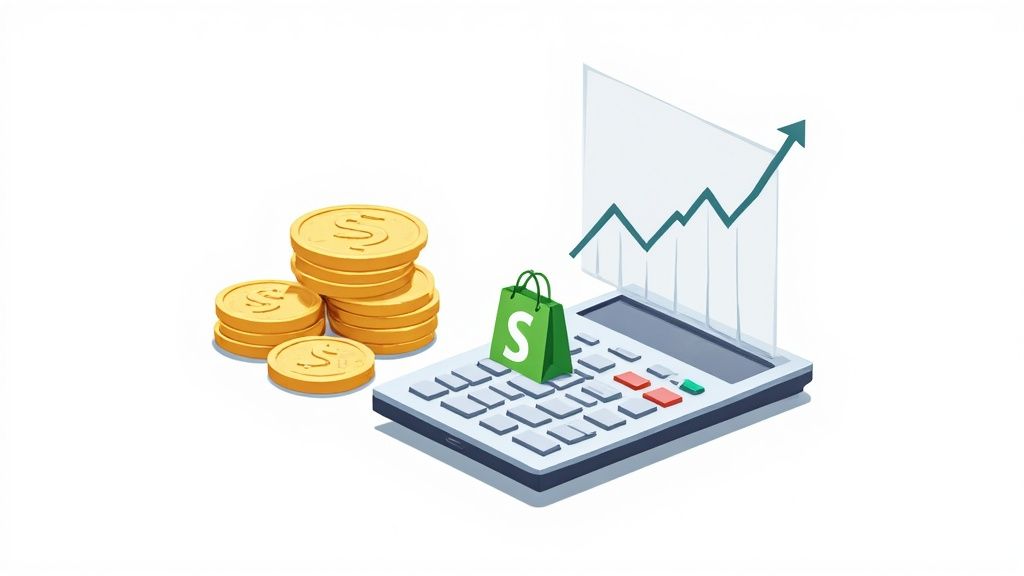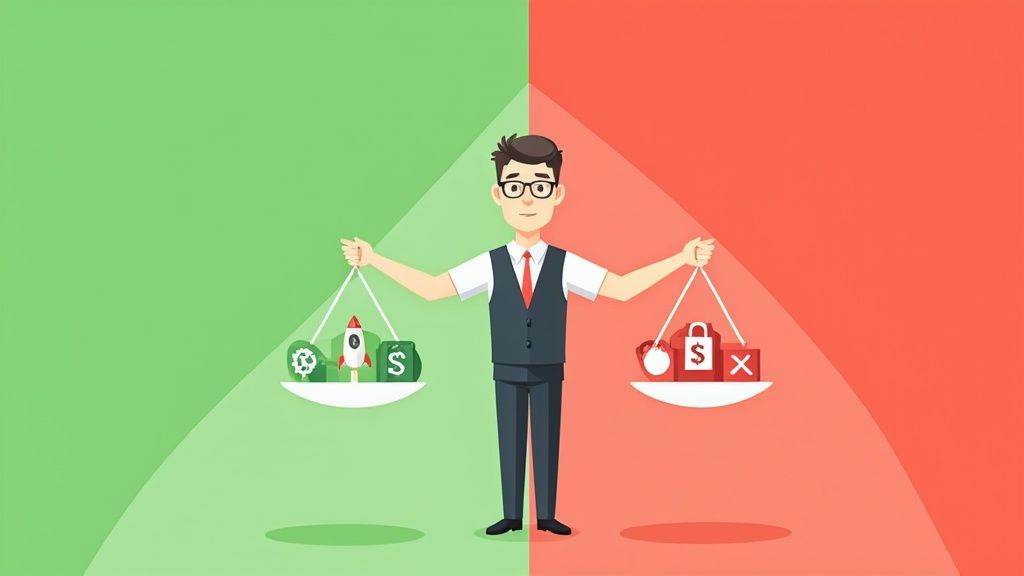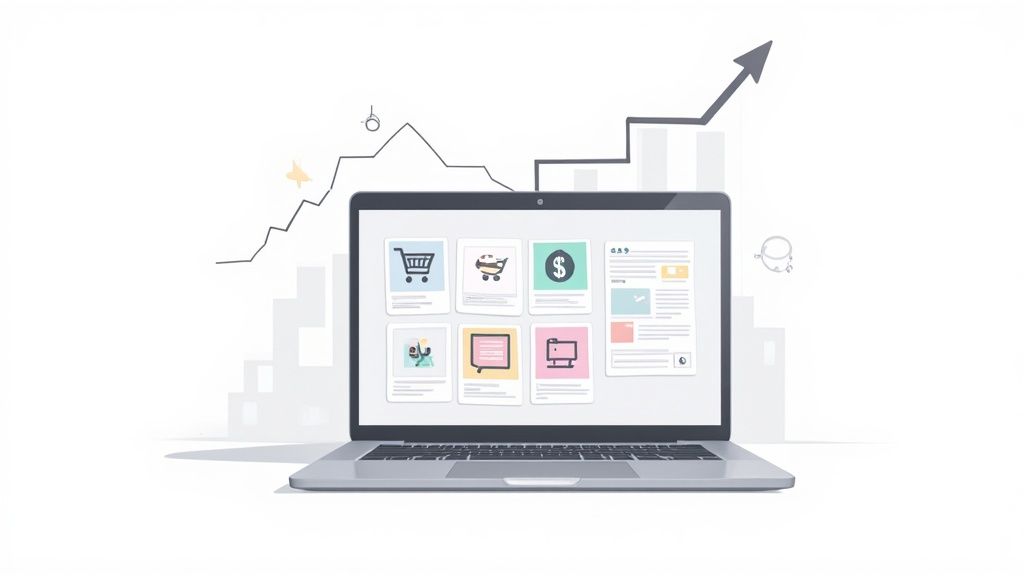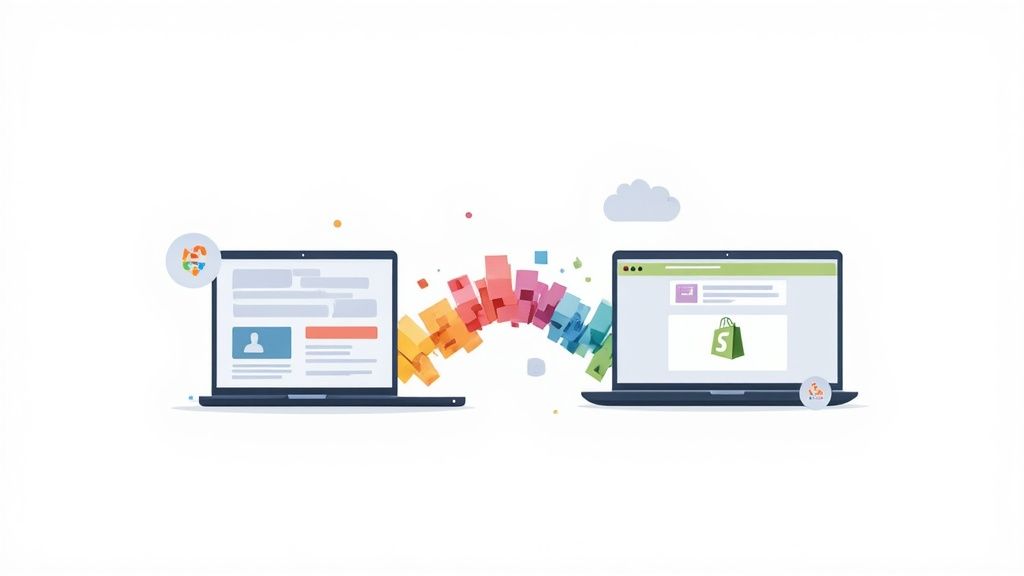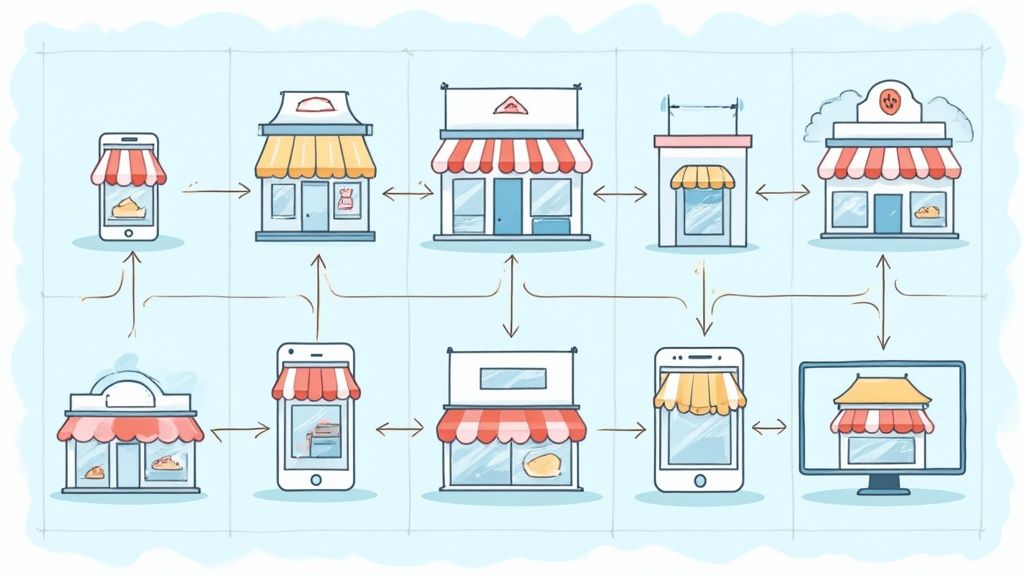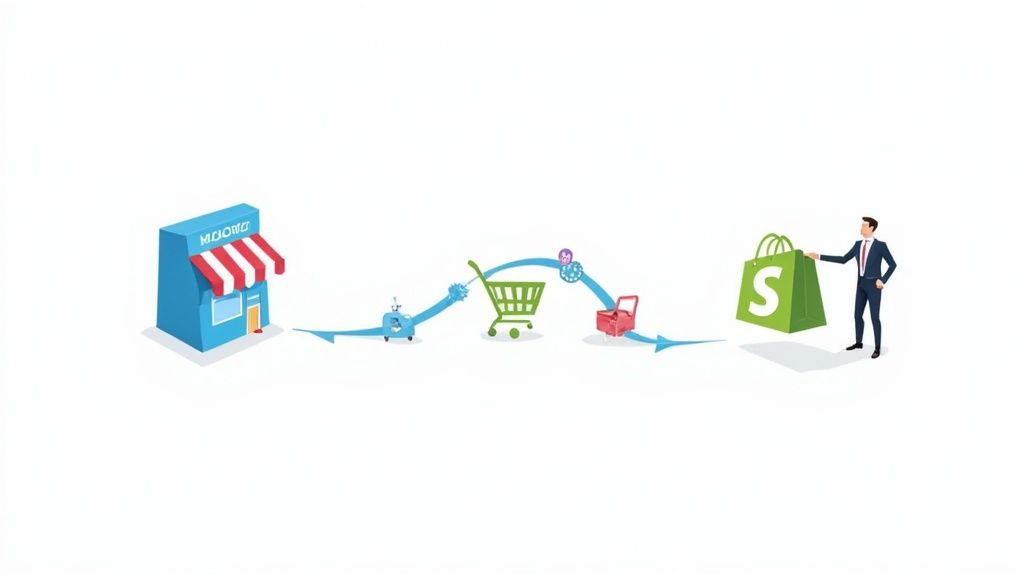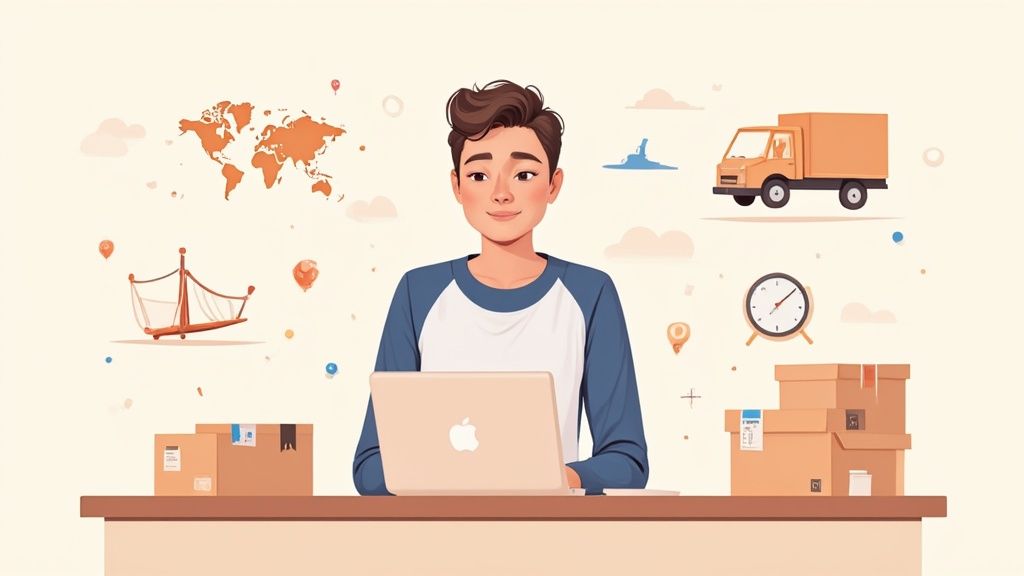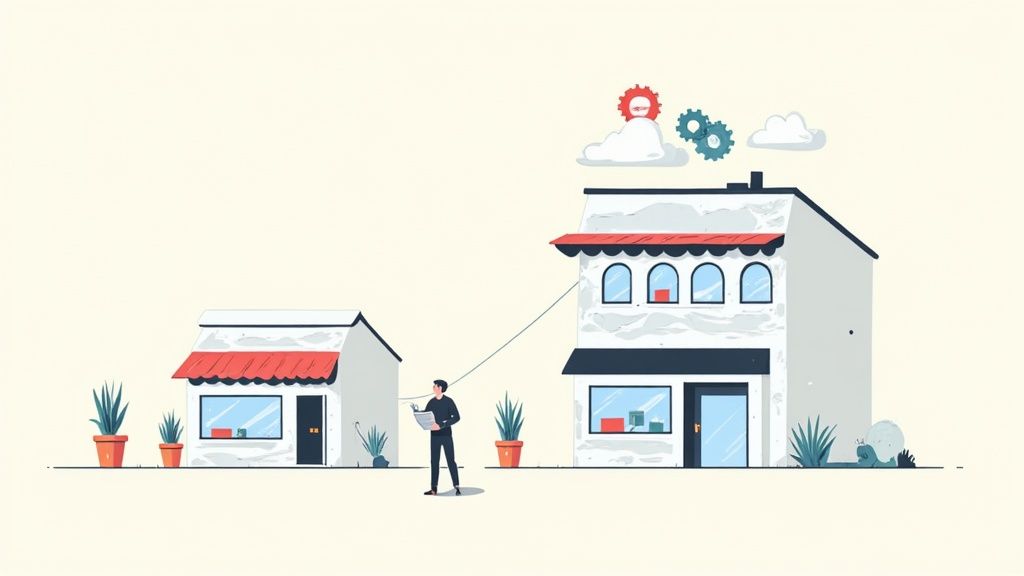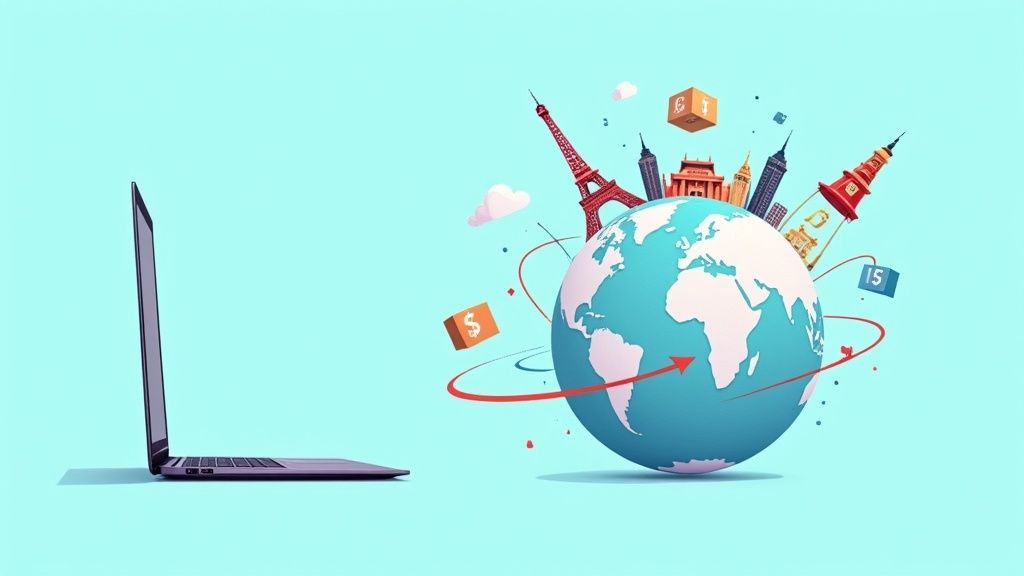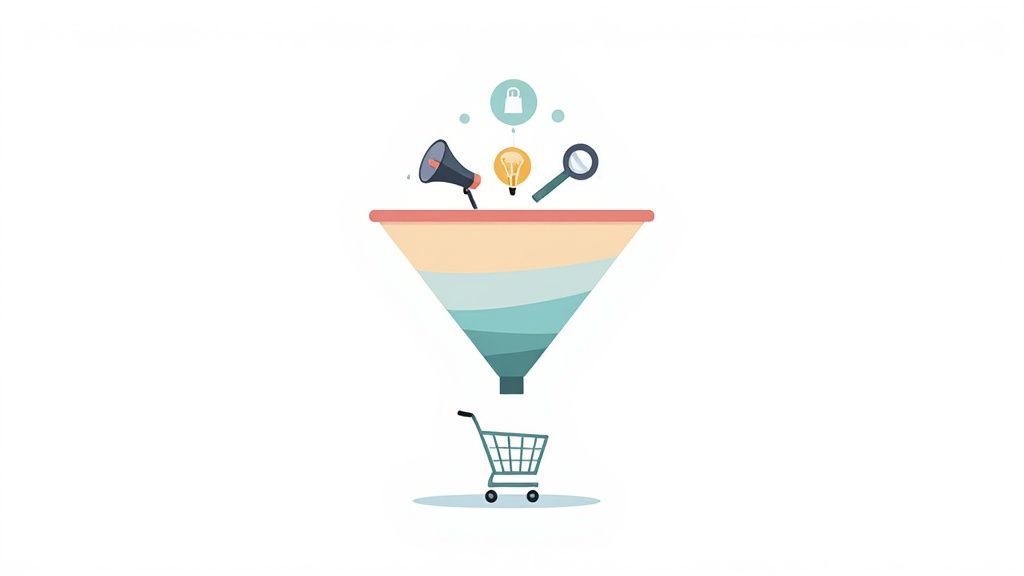
Ever wonder how random browsers turn into paying customers? It's not magic. There’s a predictable path they follow, and understanding it is the key to unlocking sustainable growth. This path is what we call the customer acquisition funnel.
Think of it as the step-by-step journey a potential customer takes, starting from the very first time they hear about your brand all the way to clicking "Buy Now." It’s how you systematically turn complete strangers into your biggest fans.
Why The Customer Acquisition Funnel Is Your Growth Engine
Imagine your eCommerce store is a hot new restaurant in a busy part of town. Plenty of people will walk by, but not all of them will stop to look at the menu. Of those who check out the menu, only a fraction will step inside. And of those who come in, not everyone will end up ordering a full meal.
The customer acquisition funnel is what helps you make sense of this flow. It’s the framework that shows you exactly where people are dropping off, so you can stop guessing and start fixing the leaks.
Without this map, you're essentially just shouting into the void, hoping someone hears you. You might get a few sales, but you won't know why they happened or how to get more. A well-defined funnel brings clarity, showing you what’s working and, more importantly, what’s not.
The Core Stages of the Journey
No one goes from "Who are you?" to "Take my money!" in a single step. The journey is a series of smaller commitments. Typically, this process is broken down into four key stages: awareness, interest, consideration, and conversion. The path kicks off when someone first stumbles upon your brand and wraps up when they make a purchase—which is when your customer retention efforts begin.
If you're looking to build out your own strategy from the ground up, starting with a comprehensive customer acquisition strategy template can give you a solid structure to follow for each of these stages.
At its core, the customer acquisition funnel isn't just a marketing concept; it's a diagnostic tool. It empowers you to stop guessing about your growth and start making strategic, data-driven decisions that directly impact your bottom line.
To give you a clearer picture, here’s a quick summary of what happens at each stage of the funnel.
The Four Stages of the Customer Acquisition Funnel at a Glance
This table neatly shows how a customer's mindset shifts and which channels are most effective for guiding them from one stage to the next.
This infographic simplifies the primary stages, showing how a large audience at the top narrows down to converted customers at the bottom.
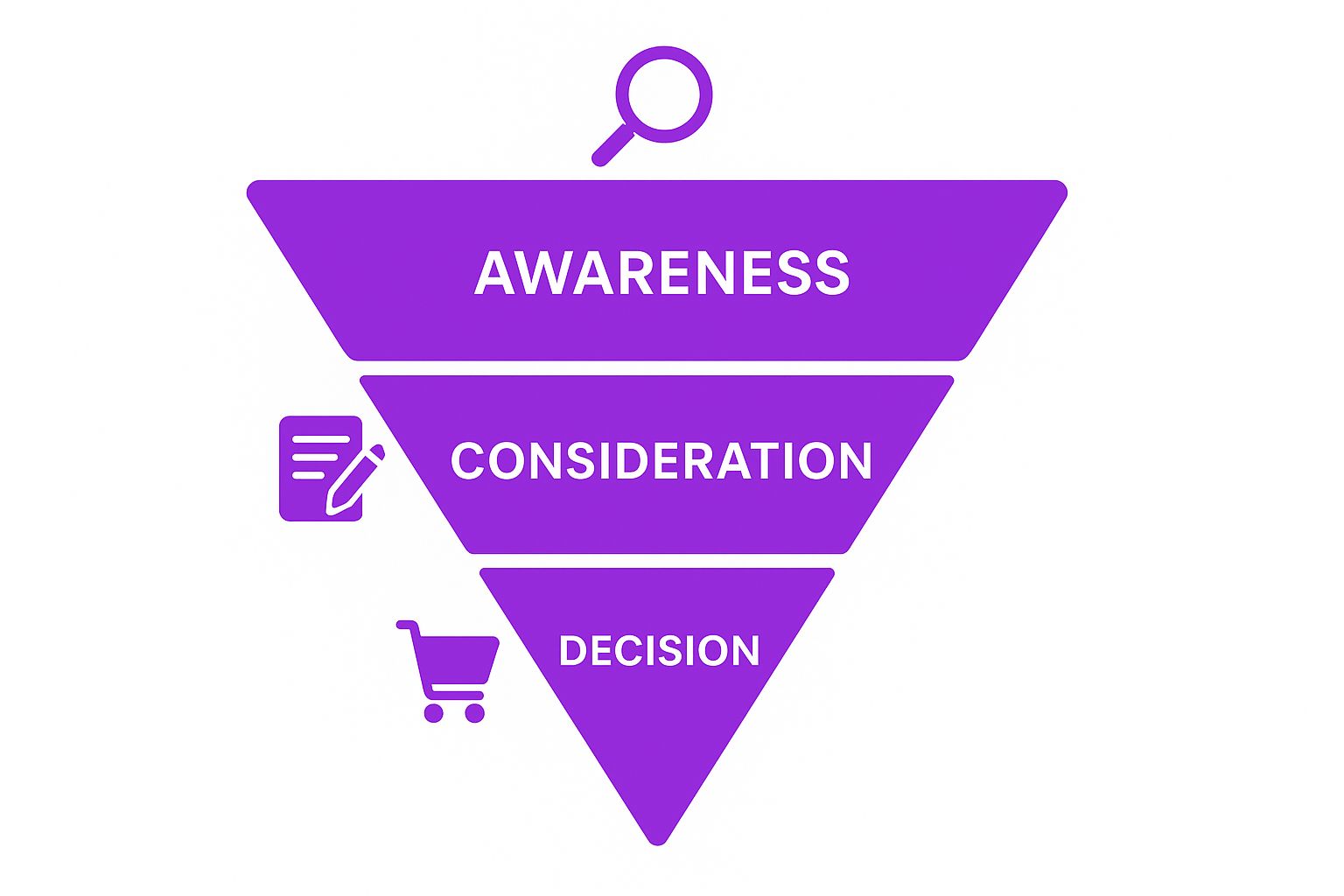
As the visual makes clear, you need to cast a wide net at the 'Awareness' stage to end up with a healthy number of qualified buyers at the 'Decision' stage. It's a numbers game, but a strategic one.
Why This Is Non-Negotiable For eCommerce
For any Shopify store owner, mastering the funnel isn't just a good idea—it's essential for survival. It provides a system for turning your website traffic into actual revenue. By breaking down each phase, you can finally get answers to the questions that keep you up at night:
- Awareness: Are my Instagram ads and blog posts actually reaching the right people?
- Consideration: Is my product page convincing enough for someone to hit "Add to Cart"?
- Decision: What's causing 70% of my shoppers to abandon their carts at checkout?
When you understand your funnel, marketing stops being a cost center and becomes a predictable engine for growth. It’s the difference between merely hoping for sales and building a machine that reliably generates them.
Building Awareness to Fill Your Funnel
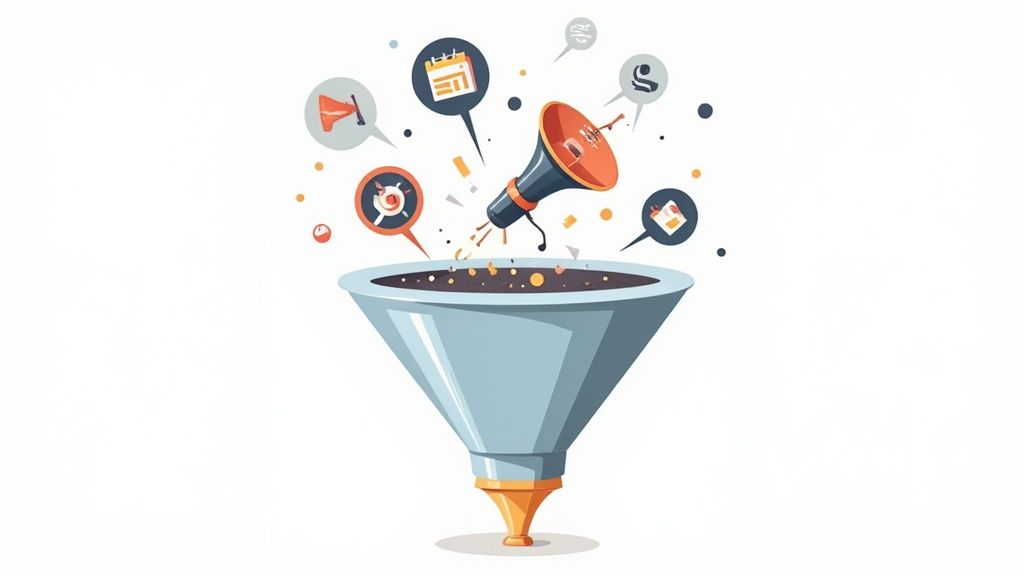 A customer's journey with your brand doesn't just magically start when they land on your homepage. It begins much earlier, with a simple moment of discovery. This is the awareness stage, and it’s all about casting a wide, intelligent net to grab the attention of people who might not even know your brand—or a solution like yours—even exists.
A customer's journey with your brand doesn't just magically start when they land on your homepage. It begins much earlier, with a simple moment of discovery. This is the awareness stage, and it’s all about casting a wide, intelligent net to grab the attention of people who might not even know your brand—or a solution like yours—even exists.
Think of it like putting up a really cool billboard on a digital highway where your ideal customers are constantly driving. You’re not trying to sell them a car right then and there. You're just introducing yourself and planting a seed of curiosity. This first touchpoint is the foundation for everything that follows.
Capturing Attention with Content and SEO
At the very top of your funnel, the goal is to attract, not to sell. This is where content marketing and search engine optimization (SEO) become your most trusted tools. The game here is to create genuinely helpful content that answers the questions your potential customers are typing into Google.
For example, if your Shopify store sells high-performance running shoes, you're not just running ads that scream "Buy our shoes!" Instead, you're publishing blog posts like "5 Common Running Injuries and How to Prevent Them" or "A Beginner's Guide to Training for a 5K." This strategy positions you as a helpful expert, not just another retailer, building trust from that very first click.
A huge part of filling your funnel is pulling in the right kind of visitors, especially from organic search. To really dig in, you can explore practical methods for how to increase organic traffic and start seeing real growth in your top-of-funnel audience.
Using Social Media and Paid Ads
While SEO is a long game that builds over time, social media and paid ads give you a more immediate way to generate awareness. These channels let you get in front of specific audiences based on their interests, demographics, and what they do online.
Let's say you run an eCommerce shop for sustainable home goods. You could run a targeted Instagram campaign with a video titled "3 Simple Swaps for a Zero-Waste Kitchen." The ad isn't pushy. It educates and engages, making people actually stop scrolling to watch.
Key Insight: The goal of awareness-stage advertising isn't direct sales; it's to earn a click, a follow, or just a moment of their attention. Success here is measured by how many of the right people you can introduce your brand to, not by immediate revenue.
A few effective strategies for this stage include:
- Influencer Collaborations: Team up with creators your target audience already knows and trusts. It’s a powerful way to get an authentic introduction.
- Engaging Video Content: Short-form videos on platforms like TikTok and Instagram Reels are perfect for grabbing attention and showing off your brand's personality.
- Targeted Facebook Ads: Use lookalike audiences to find people who are similar to your existing customers. This dramatically increases the chances of attracting a relevant crowd.
Measuring Awareness Success
So, how do you know if any of this is actually working? At this stage, you aren't looking at sales or add-to-carts. You're focused on top-of-funnel metrics that show you your reach and engagement.
Keeping an eye on these numbers tells you if you're successfully filling the top of your customer acquisition funnel.
Top-of-Funnel Metrics to Track
By tracking these KPIs, you can get a clear picture of how your campaigns are performing and make smart, data-backed tweaks. If an ad gets tons of impressions but a really low CTR, your targeting might be on point, but your creative or message isn't hitting the mark. This constant cycle of testing and adjusting is how you build a powerful awareness machine.
Nurturing Leads from Interest to Consideration
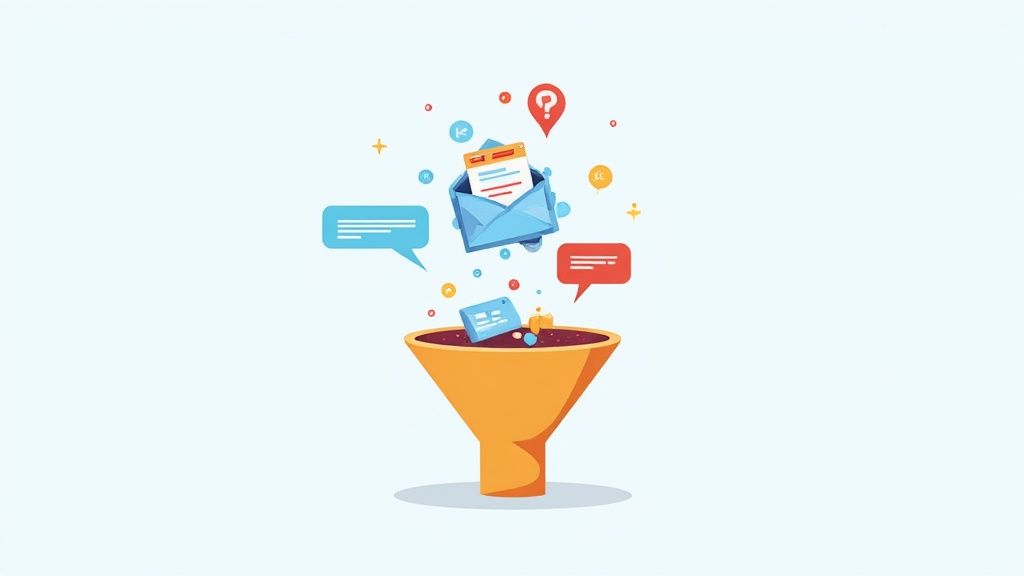
Alright, so you've managed to grab someone's attention. That's a huge first step. But now, the real work begins. We're moving from a broad introduction into a much more focused conversation. This is the heart of the customer acquisition funnel, where a flicker of interest has the potential to become serious consideration. They know you exist; now your job is to guide them from "that's cool" to "this might be exactly what I need."
This middle stage is all about building relationships and earning trust. You’re no longer just a digital billboard they drove past. You're becoming the go-to resource they think of when they start really looking for a solution. It's about providing real value, not just a hard sell.
From Casual Browser to Engaged Prospect
You'll know someone is moving from interest to consideration by a clear shift in their behavior. They're no longer just passively reading a blog post. Instead, they're taking action: downloading a guide, subscribing to your newsletter, or following your brand on social media. They're raising their hand and saying, "I'm interested, tell me more."
This is your signal to start the nurturing process. The trick is to deliver the right information at just the right time, helping them understand their own needs better while gently showing how your product fits into the picture.
It's a delicate dance. A study revealed that a massive 74% of buyers ultimately go with the company that first helped them on their journey. But, if you come on too strong with aggressive sales pitches, you'll send them running. The entire focus has to be on educating and empowering them.
Building Trust with Email Nurturing Sequences
Email marketing is your undisputed champion in the consideration stage. A thoughtfully planned email sequence can systematically build that crucial trust and guide a prospect toward making a purchase. Forget the single, generic "welcome" email. Think of this as a multi-part conversation.
Key Takeaway: A great email nurture sequence feels less like a sales pitch and more like a helpful conversation. Each email should build on the last, offering value, answering questions they haven't even asked yet, and nudging them closer to a decision.
For an eCommerce brand, a simple but effective sequence might look something like this:
- Email 1 (The Welcome & Value Add): As soon as they sign up, send them what they asked for (like that "Summer Style Guide"). Use this email to also reinforce your brand's mission and set expectations for what's to come.
- Email 2 (The Pain Point Agitator): A few days later, hit them with an email that zeroes in on a common problem your audience has—one that your product just so happens to solve. Think: "Tired of clothes that lose their shape after one wash?"
- Email 3 (The Solution & Social Proof): Now, you introduce your product as the answer. Link them to a relevant category or product page, but don't stop there. Pack this email with compelling customer testimonials or user-generated content to show them that real people love your stuff.
Crafting High-Converting Shopify Product Pages
As your prospects get deeper into this stage, they'll inevitably find their way to your product pages. This is where your Shopify store has to deliver the goods. A killer product page does more than just list specs; it sells a transformation.
To really optimize your product pages for conversions, you absolutely need:
- High-Quality Visuals: Professional photos and videos are non-negotiable. Show the product from every angle, in different contexts, and being used by real people.
- Benefit-Oriented Descriptions: Don't just tell them it's "made from 100% organic cotton." Tell them to "Experience breathable, all-day comfort with our ultra-soft organic cotton." Sell the feeling, not just the feature.
- Clear Social Proof: Make your star ratings, customer reviews, and any user-generated photos impossible to miss. Seeing that other people are happy with their purchase is incredibly persuasive.
- Trust Badges: Little icons for secure checkout, free shipping, and your return policy can work wonders to soothe any last-minute buying anxiety.
Effectively guiding leads through this middle part of the funnel is what separates the brands that struggle from the ones that scale. It's how you maximize the return on your marketing efforts. To really understand if you're profitable, you have to know your numbers. We break it all down in our guide on how to calculate customer acquisition cost. It will help you make sure your nurturing strategy isn't just working, but also making you money.
Driving Conversions and Closing the Deal
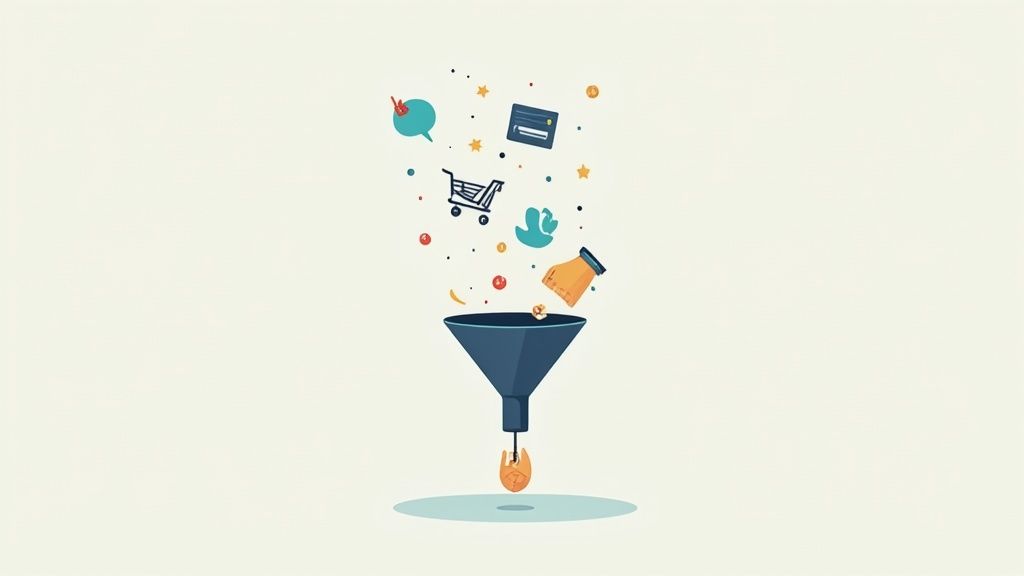 You’ve done the heavy lifting, guiding your prospect from a curious bystander to someone seriously considering a purchase. This is the moment of truth. The conversion stage is where all your effort pays off, finally turning that interested browser into a paying customer. This last step in the customer acquisition funnel is all about making the "yes" as easy as humanly possible.
You’ve done the heavy lifting, guiding your prospect from a curious bystander to someone seriously considering a purchase. This is the moment of truth. The conversion stage is where all your effort pays off, finally turning that interested browser into a paying customer. This last step in the customer acquisition funnel is all about making the "yes" as easy as humanly possible.
Think of your checkout page as the final five yards before the end zone. The customer has the ball, they're ready to score, but any fumbles or obstacles now could mean losing the game entirely. Your job is to clear the path and give them absolute confidence to cross that finish line.
Crafting a High-Converting Checkout Experience
Did you know the average eCommerce store loses a staggering 70% of its customers at the checkout stage? The number one culprit is friction. A confusing, long, or untrustworthy checkout process will absolutely kill your conversions. To fight this, your single-minded goal is to create an experience that feels seamless, secure, and reassuring.
If you're on Shopify, this means stripping your checkout down to the bare essentials. Get rid of any unnecessary fields, distracting pop-ups, or navigation links that could tempt them to click away. Every single element should serve one purpose: guiding the customer to complete their purchase.
Key Takeaway: Your checkout page isn't the place for last-minute marketing. It's a purely functional space designed for a single, focused action. Make it simple, fast, and trustworthy to maximize your conversion rate.
To build that crucial trust, make sure to display security badges prominently. Offer multiple payment options like Shop Pay or PayPal, and clearly state your shipping and return policies. These small details provide that final dose of confidence a customer needs before handing over their payment info.
The Power of Compelling Calls-to-Action
A Call-to-Action (CTA) is so much more than a button; it's the final command that tells a user what to do next. Vague or passive language like "Submit" or "Continue" can create a moment of hesitation. Your CTAs need to be direct, crystal clear, and focused on the benefit.
Instead of a generic button, use action-packed text that reminds them of the value they're about to get.
Weak CTA: "Proceed to Checkout"
Strong CTA: "Secure My Order Now"
Weak CTA: "Submit"
Strong CTA: "Get My 20% Discount"
The wording, color, and placement of your CTA can make a massive difference. This is the perfect playground for A/B testing. Test a vibrant green button against a standard blue one, or experiment with different text to see what truly connects with your audience.
Applying CRO and Recovering Lost Sales
Conversion Rate Optimization (CRO) is the ongoing practice of testing and tweaking your funnel to get more users to convert. It’s all about making data-driven improvements, not just guessing what might work. Tools like heatmaps can be incredibly revealing, showing you exactly where people are getting stuck or bailing.
Even with a flawless checkout, cart abandonment is a fact of life. This is where your recovery strategy kicks in. Setting up an automated cart abandonment email sequence is non-negotiable for any serious eCommerce store.
These aren't just simple reminders. A good sequence might look something like this:
- Email 1 (1 hour later): A friendly nudge, maybe asking if they ran into a technical issue.
- Email 2 (24 hours later): Reinforce the value of the products in their cart, maybe sprinkle in some social proof like customer reviews.
- Email 3 (48 hours later): A final reminder, sometimes sweetened with a small, time-sensitive discount to create a bit of urgency.
By putting these tactics into practice, you can give your final conversion numbers a serious boost. It's also vital to know the industry benchmarks; the average sales funnel converts at around 2.35%, but top-tier businesses can more than double that, hitting 5.31% or even higher by relentlessly optimizing every step. You can discover more insights about these conversion statistics and learn how your landing pages play a crucial role. For a deeper dive, check out our complete guide on how to improve your eCommerce sales growth strategy. This consistent effort is what separates a good funnel from a great one.
Using AI to Supercharge Your Funnel
Let's be honest: trying to manually tweak every single step of your customer acquisition funnel is a surefire way to burn out. As your brand grows, giving every visitor a truly personal experience feels less like marketing and more like an impossible juggling act.
This is exactly where Artificial Intelligence (AI) and automation come into play. They can transform your funnel from a rigid, one-way street into a smart, responsive system that adapts to every single user. We're moving beyond one-size-fits-all marketing and into an era of intelligent customer journeys, and these tools are no longer reserved for giant corporations. They're accessible to any eCommerce brand ready to gain a serious competitive edge.
Personalizing the Customer Journey with AI
Think of it like having a digital shopping assistant who just gets every customer's unique style and knows what they'll want next. That's the magic AI brings to the top of your funnel. Instead of greeting every visitor with the same generic homepage, AI can dynamically change the content they see based on their past clicks, where they came from, or even their location.
For Shopify stores, you see this most often with AI-powered product recommendations. These tools don't just guess; they analyze a user's browsing history, what they've added to their cart, and what customers like them have bought before. The result is a curated shopping experience that feels like it was built just for them, which is a fantastic way to boost engagement and average order value.
Key Insight: The real power of AI in the funnel isn't just about doing things faster; it's about delivering hyper-personalization at scale. You get to treat every visitor like an individual, even when you have thousands on your site at once.
This kind of personalized touch has a huge impact on your numbers. Funnel optimizations like personalization and retargeting are proven to move the needle. For instance, retargeted ads can boost conversions by 147%, and personalized calls-to-action crush standard CTAs by an incredible 202%. You can dig into more of these powerful sales funnel statistics to see how different tactics perform.
Deploying AI for Smarter Communication
Solid communication is vital as customers are considering a purchase, but your team can't be everywhere 24/7. This is where AI-powered chatbots become your best friend, offering instant, around-the-clock support to shoppers with questions.
And these aren't the clunky, robotic bots from a few years ago. Modern chatbots understand natural language, can pull up specific product information, and even help guide a hesitant user through the checkout process.
- Instant Answers: A customer is up at 2 AM wondering about your return policy. Instead of leaving, they get an immediate, accurate answer.
- Proactive Engagement: You can set up chatbots to pop up and engage visitors who are lingering on a product page, asking if they need help or even offering a small discount.
- Lead Qualification: They can ask a few key questions to qualify a lead, saving your human support team's time for the more complex, high-touch issues.
This instant support system smoothes out the friction at a make-or-break point in the funnel, helping to reduce drop-offs and build the trust needed to make a purchase.
Automating Retargeting and Ad Campaigns
One of the most potent uses for AI in the acquisition funnel is in your advertising. AI algorithms can chew through massive datasets to build hyper-targeted retargeting campaigns that bring back on-the-fence buyers with surgical precision.
Forget just showing someone a generic ad for a product they glanced at. AI takes it so much further:
- Segment Audiences: It can automatically bucket users based on their intent. Someone who just viewed a product is different from someone who abandoned a full cart, and your ads should reflect that.
- Optimize Ad Creative: AI can A/B test different images, headlines, and offers to figure out what truly clicks with each audience segment, then double down on the winners.
- Predictive Bidding: It adjusts your ad spend in real-time, putting more money behind the users who are showing the strongest signals that they're about to convert. This maximizes your return on ad spend (ROAS).
When you weave these technologies into your strategy, you're not just running a funnel; you're building a self-improving engine that gets smarter with every single customer interaction. It frees you from repetitive tasks, lets you deliver deeply personal experiences, and ultimately, helps you convert more visitors into loyal customers, far more efficiently.
Measuring What Matters at Every Stage
Trying to grow an eCommerce business without tracking data is like flying a plane with no instruments. You might feel like you're moving forward, but you have no real idea where you're going, how fast you're getting there, or if you're about to crash. To actually pilot your customer acquisition funnel effectively, you need to measure what matters at each specific stage. This turns abstract numbers into real-world insights that actually drive growth.
This isn't about getting lost in a spreadsheet jungle. It’s about being selective and focusing on the Key Performance Indicators (KPIs) that tell you the real story of how your marketing is performing. Think of each stage as having its own unique health chart; you need to monitor the right vital signs to spot problems and jump on opportunities.
Top-of-Funnel Health Checks
At the top of the funnel—the Awareness stage—your only job is to attract a broad but relevant audience. Forget about sales for a moment. The metrics here are all about reach and first impressions. You need to know if your brand is getting in front of the right people and if your message is interesting enough to make them stop scrolling and click.
- Impressions and Reach: Simply put, how many people are seeing your ads and content? This gives you a sense of your total potential audience size.
- Website Traffic: Are those impressions turning into actual visitors? You absolutely have to track this by source (social, search, email, etc.) to see which channels are pulling their weight.
- Cost Per Click (CPC): For paid ads, how much is each click costing you? This is your gut check for ad spend efficiency.
These numbers are your early warning system. For example, if you have tons of impressions but barely any traffic, it's a huge red flag. It probably means your targeting is okay, but your ad creative or copy is falling flat.
The most bulletproof acquisition strategies are built on a solid foundation of data. The game is all about attracting prospects with the lowest possible Customer Acquisition Cost (CAC) and the highest Customer Lifetime Value (LTV)—a balancing act that demands sharp tracking at every single step.
Mid-Funnel and Bottom-Funnel Diagnostics
As people move deeper into your funnel, your focus has to shift. We're moving away from broad awareness metrics and zooming in on specific actions that signal real buying intent. Now you're measuring how effectively you're converting interest into sales.
Of course, to measure success across the entire journey, you have to understand the crucial marketing performance metrics that tie everything together and give your data context.
When you get to the bottom, it all boils down to one thing: profitability.
- Conversion Rate: What percentage of your visitors are taking that final, critical step, like adding a product to their cart or completing a purchase? This is probably the most important indicator of your funnel's overall health.
- Customer Acquisition Cost (CAC): How much does it cost, in total, to get one new paying customer? You find this by dividing your total marketing spend by the number of new customers you brought in.
- Customer Lifetime Value (LTV): What's the total amount of revenue you can realistically expect from one customer over their entire relationship with your brand? For a business to survive, let alone thrive, your LTV must be significantly higher than your CAC.
Essential Funnel Metrics and Tracking Tools
Keeping all these metrics straight can feel overwhelming. The key is to organize them by funnel stage so you know exactly what to look for and where to find the data. This table breaks down the most important KPIs for each stage and the common tools you'll use to track them.
By connecting these specific numbers to each part of your customer acquisition funnel, you stop guessing and start making informed decisions. You can see exactly where your funnel is leaking money and apply the right fix, ensuring your marketing dollars translate directly into sustainable, profitable growth.
Even with a solid plan, you're bound to run into questions when you start putting a real-world customer acquisition funnel into practice. Let's tackle some of the most common ones head-on so you can move forward with confidence.
Where Do Most Customers Drop Off?
From what I've seen, customers tend to disappear at two key moments. The first is that leap of faith from Awareness to Consideration. This is where your content just doesn't grab them enough to earn an email signup or a deeper look. They see you, but they aren't compelled to engage.
The second, and much bigger, leak happens right at the finish line: the checkout stage. It's almost hard to believe, but a staggering 70% of online shopping carts are abandoned. This usually boils down to sticker shock from unexpected shipping costs, a checkout process that feels like a chore, or a simple lack of trust signals like security badges and a clear return policy. Finding these friction points is the first step to plugging the leaks.
How Long Until I See Results?
That really depends on your strategy. If you're running paid ad campaigns, you can start seeing traffic and collecting data almost immediately. This gives you a quick read on your top-of-funnel performance within a matter of days.
Optimizing your entire funnel isn't a one-and-done task; it's a long-term commitment. You might see quick wins from A/B testing a button color, but the real, sustainable growth in metrics like Customer Lifetime Value (LTV) comes from months of consistent effort and analysis.
On the other hand, strategies like SEO and content marketing are more of a slow burn. You're building an asset, and that takes time. It can easily take 3-6 months before you start seeing a steady, reliable flow of organic traffic. Patience is everything here—these channels build compounding value that pays off for years.
How Should I Adapt the Funnel for Different Products?
Your funnel is not a one-size-fits-all template; it has to match what you're selling.
- Low-Cost, Impulse Buys: For these kinds of items, the funnel needs to be short and sweet. The goal is to get from "Ooh, I want that" to "Purchase complete" as fast as humanly possible. Think sharp, benefit-focused social media ads that click straight through to a simple, no-fuss product page.
- High-Ticket, Considered Purchases: For anything expensive or complex, the Consideration stage is where the magic happens. This part of the funnel needs to be much longer and more robust. You'll need to build trust over time with things like detailed email sequences, in-depth buyer's guides, webinars, and a ton of social proof.
Ready to turn your customer acquisition funnel from a leaky bucket into a high-performance growth engine? The team of Shopify and CRO experts at ECORN can help you diagnose issues, optimize every stage, and drive conversions. Get in touch today to see how we can help your brand scale.








